Santiago with Chris Whatmore
This is the first of what will be many posts from the South American country of Chile which Alison and I will tour from almost top to bottom including a visit to Easter Island with our preferred tour company Adventures Abroad. However, before meeting up with the other members of our group we have come to Santiago a day in advance to have a guided tour of the city with local guide Chris Whatmore. I chose Chris from among a number of local guides because his background is English and thus I knew there would be no language difficulties as there sometimes can be with some guides who claim to be fluent in English, but simply are not.
However, before meeting with Chris we were able to do a little sightseeing on our own because our trip from Toronto to Santiago was an overnighter and we had almost a full day on our own before meeting him the next morning. Adventures Abroad uses the Pullman Viticura as their base in Santiago.
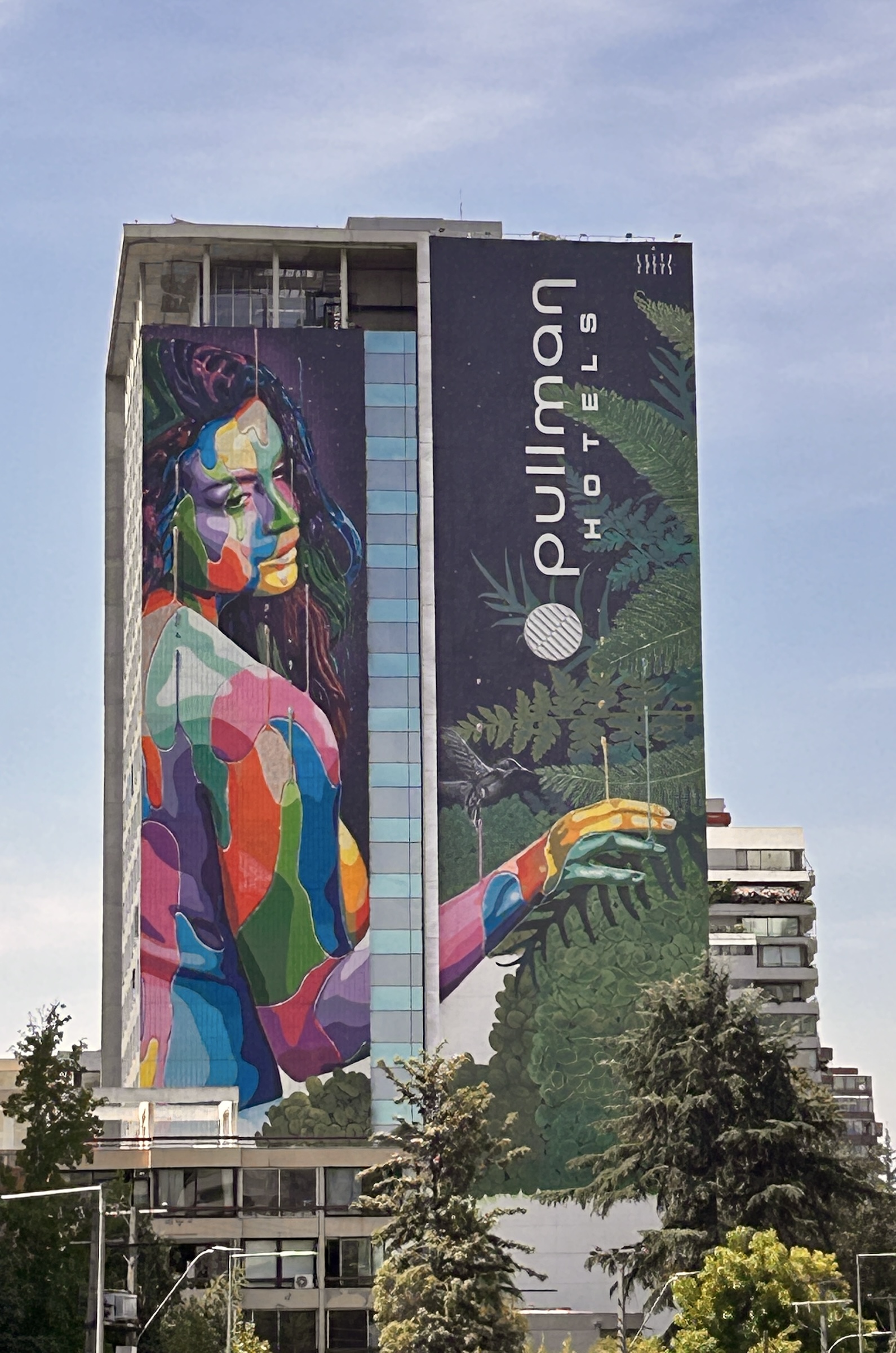
It is located in the upscale neighbourhood of Viticura within relatively easy walking distance of the Sanhattan district which contains the city’s financial core as well as El Costanera, the tallest building South America that dominates the city skyline. That’s our first destination in Santiago.
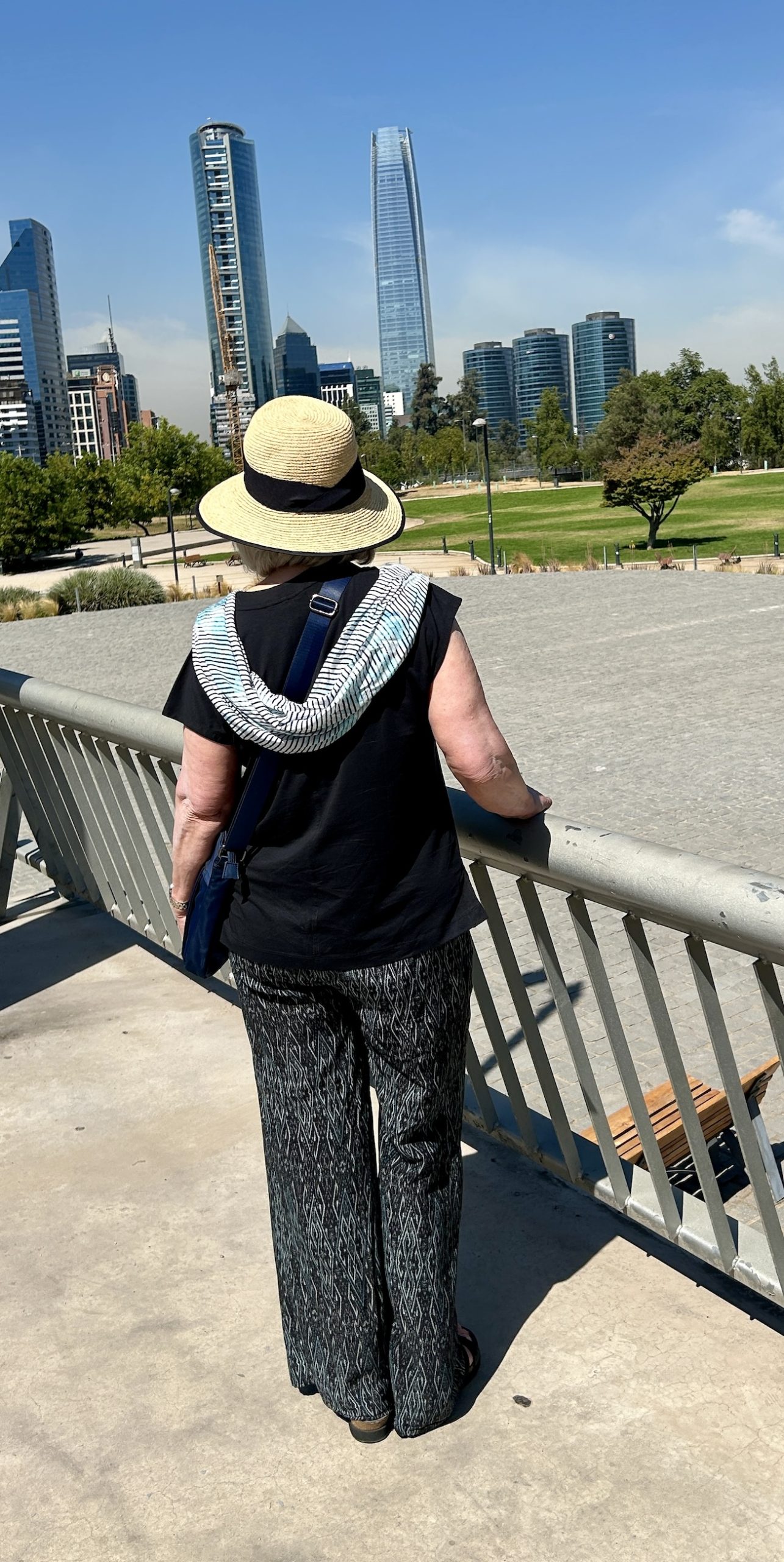
Heading there we pass the United States Embassy which is really a fortified compound, but with a commitment to Ukraine quite evident, even as traitorous Republicans side with Putin.
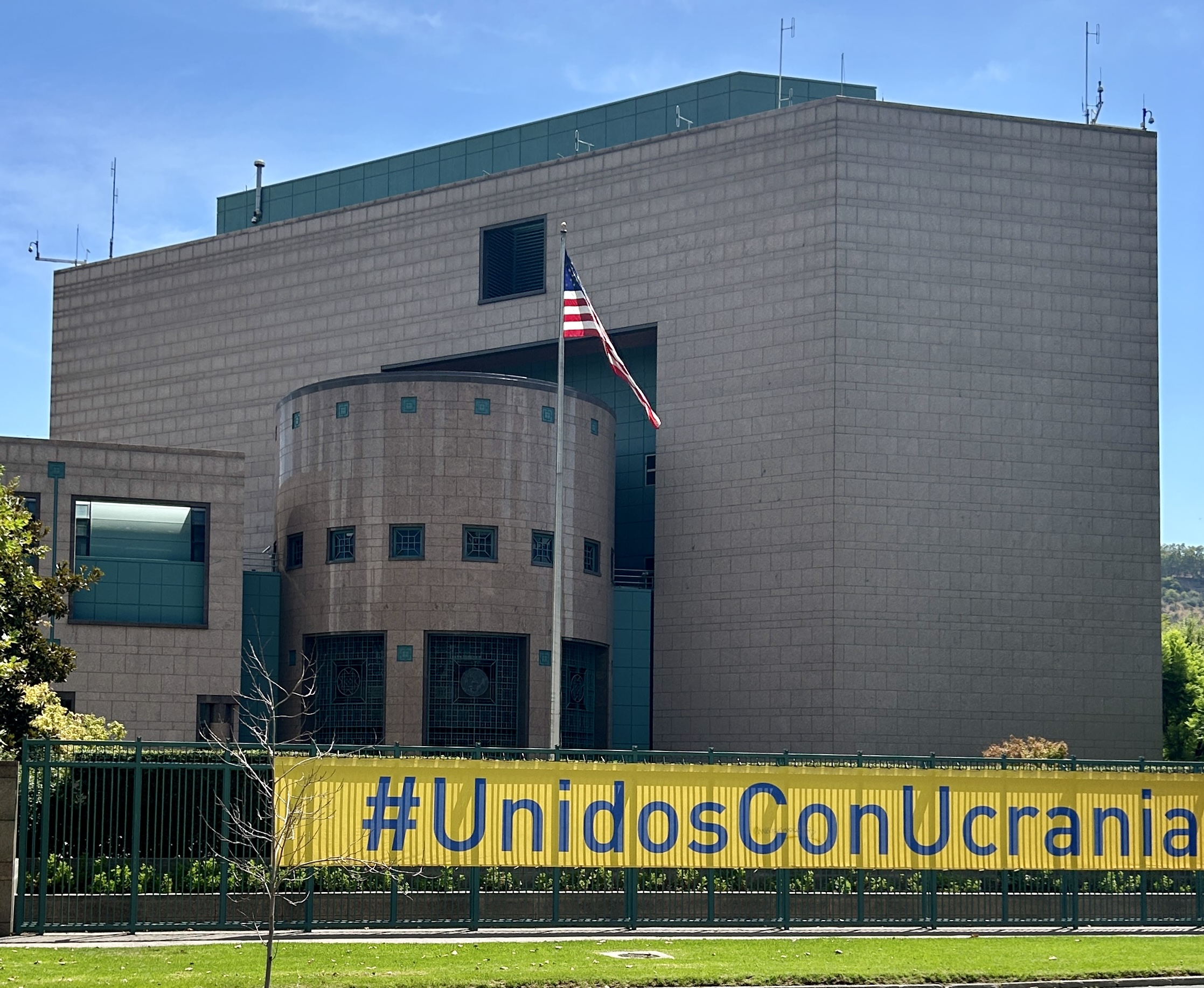
Rather than portray a forbidding image, the walls of the embassy are painted with a series of murals depicting smiling children with symbols of harmony and happiness, something not that easy to find in some places in Latin America.
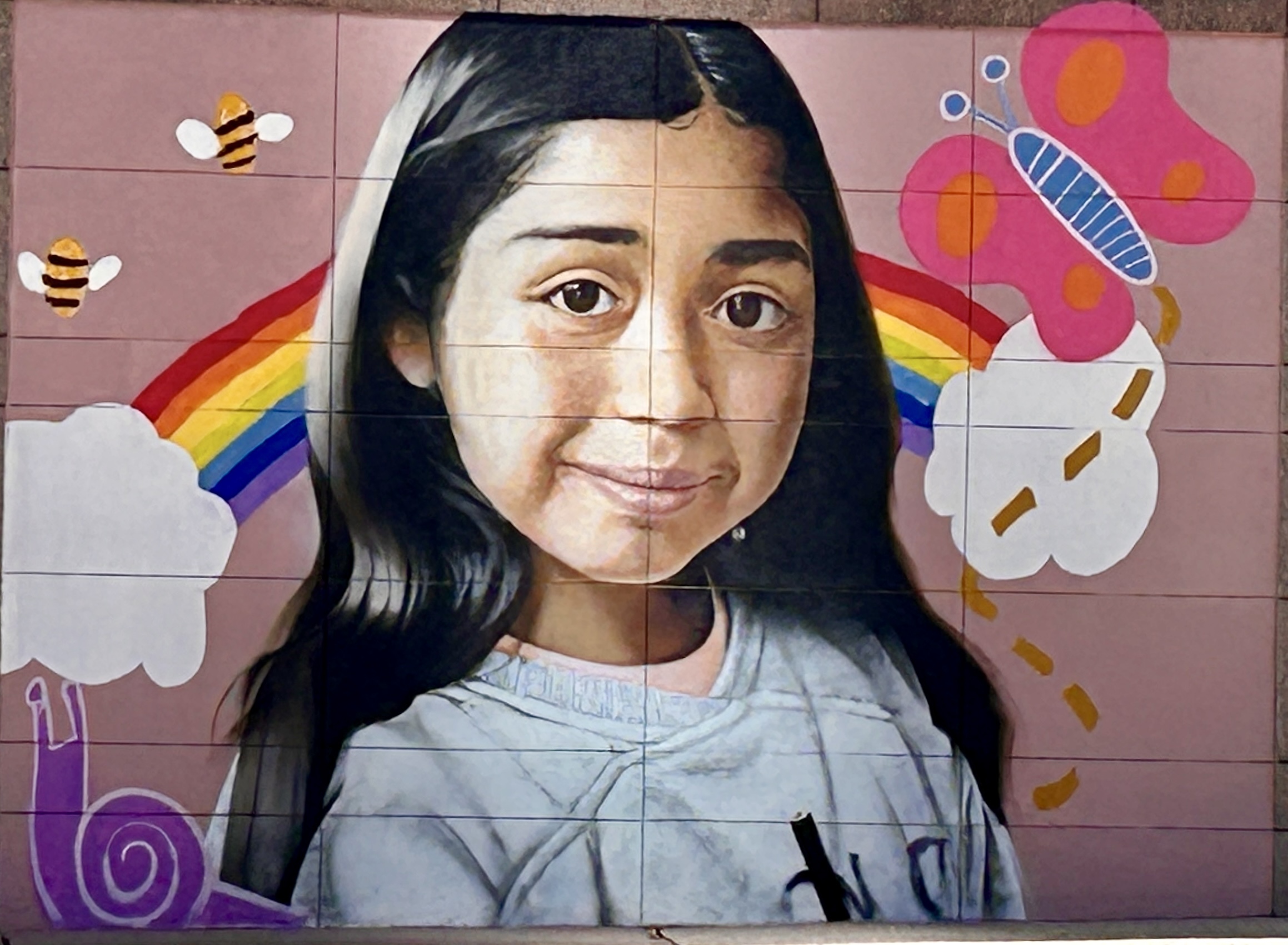
Arriving at El Costanera we pay the fee to go up to the Sky Costanera observation platform for a 360° view of Santiago. This is looking back towards our hotel with the Andes in the distance. The golf course right in the middle of the city is one of the most exclusive in South America.
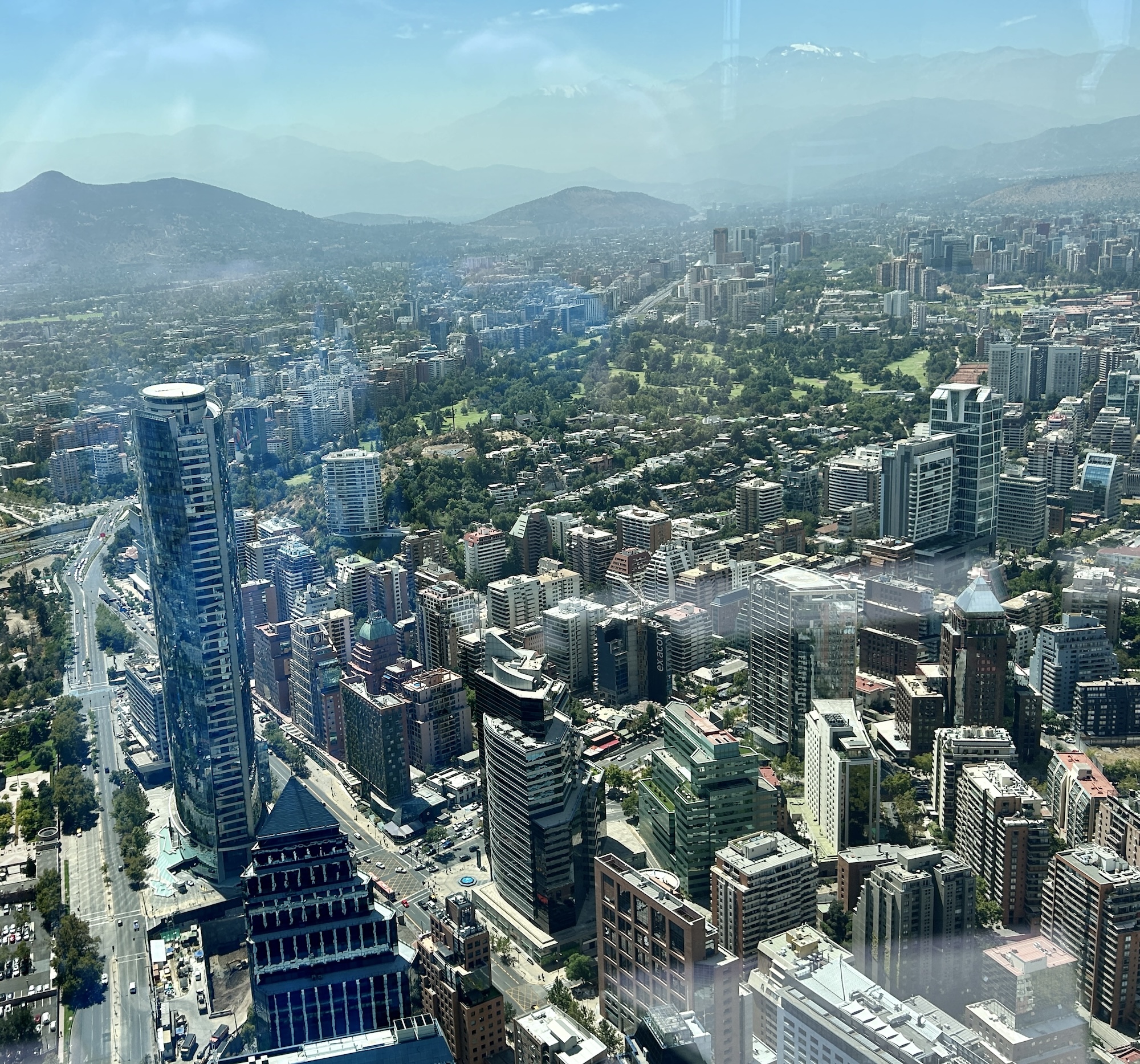
This complex is also home to the largest shopping mall in Latin America which is of zero interest to me, but what does is the food court where Peruvian restaurant Barra Chalaca is serving up a number of varieties of ceviche which is a dish I could eat every day. The fried calamari slices are a bonus.
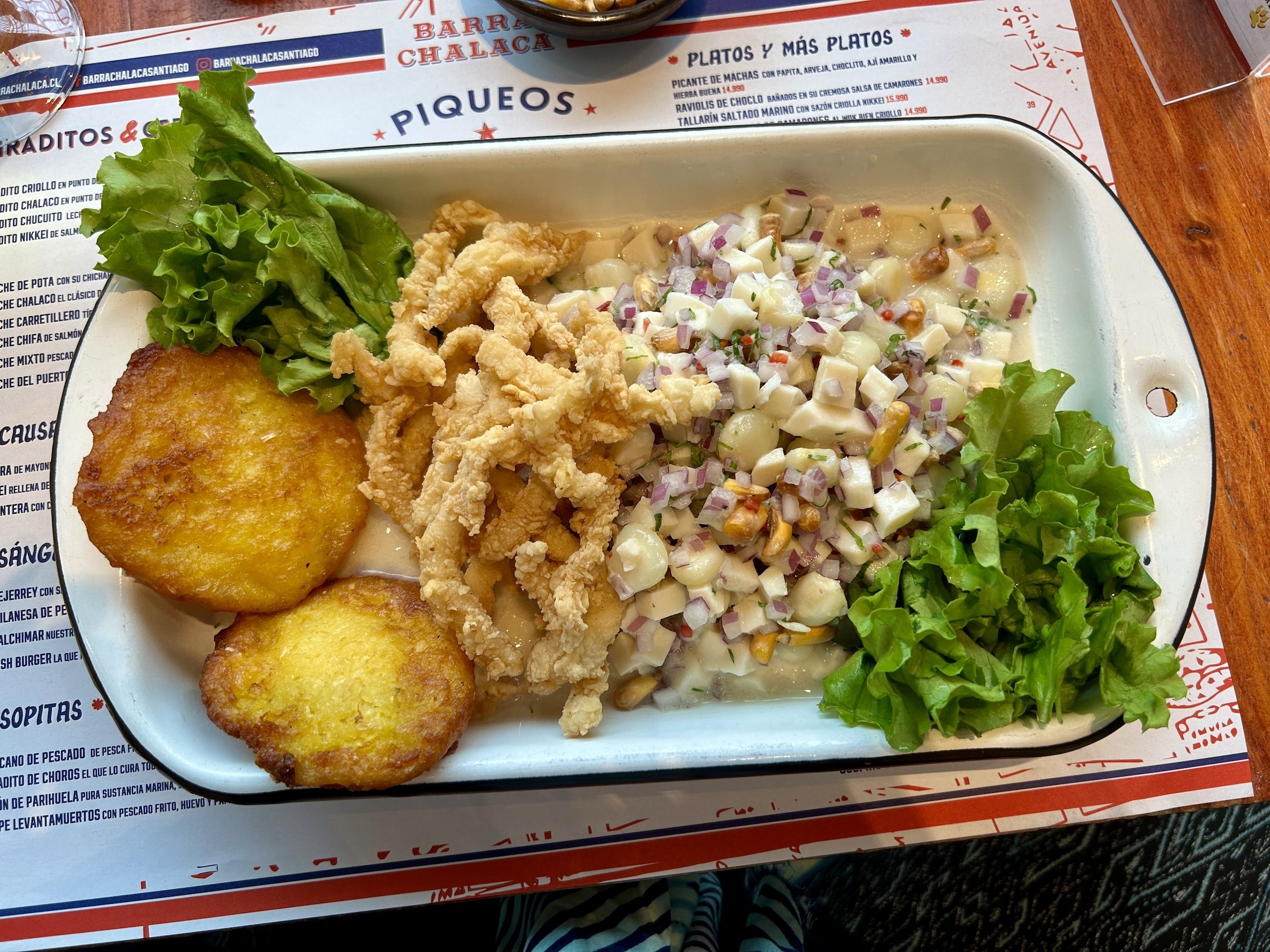
Alison has a mixed bag of fish, calamari and shrimp which is also delicious.
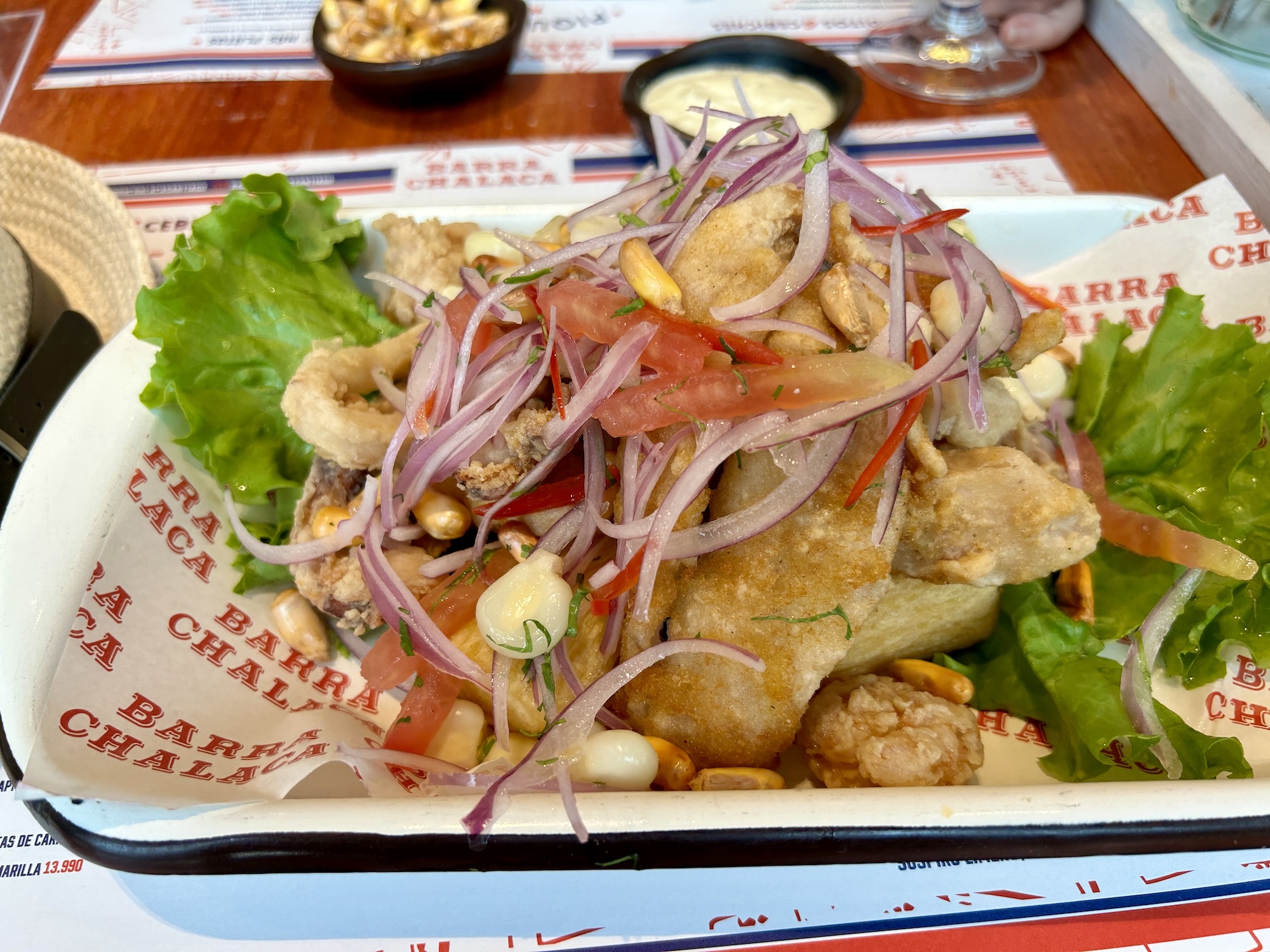
By now we were starting to feel the effects of the 10+ hour flight from Toronto so returned to the hotel to rest up.
Refreshed we now strolled around the Vitacura area and Bicentennial Park where we hoped to see our first Chilean flamingos, but no such luck. Looking for an early evening meal we decided on Romaria, an Italian restaurant with outdoor seating not far from the hotel. I forgot to mention that the weather in Santiago was absolutely perfect and for one’s fleeing the Canadian never ending winter, 30°C (86°F) felt just right.
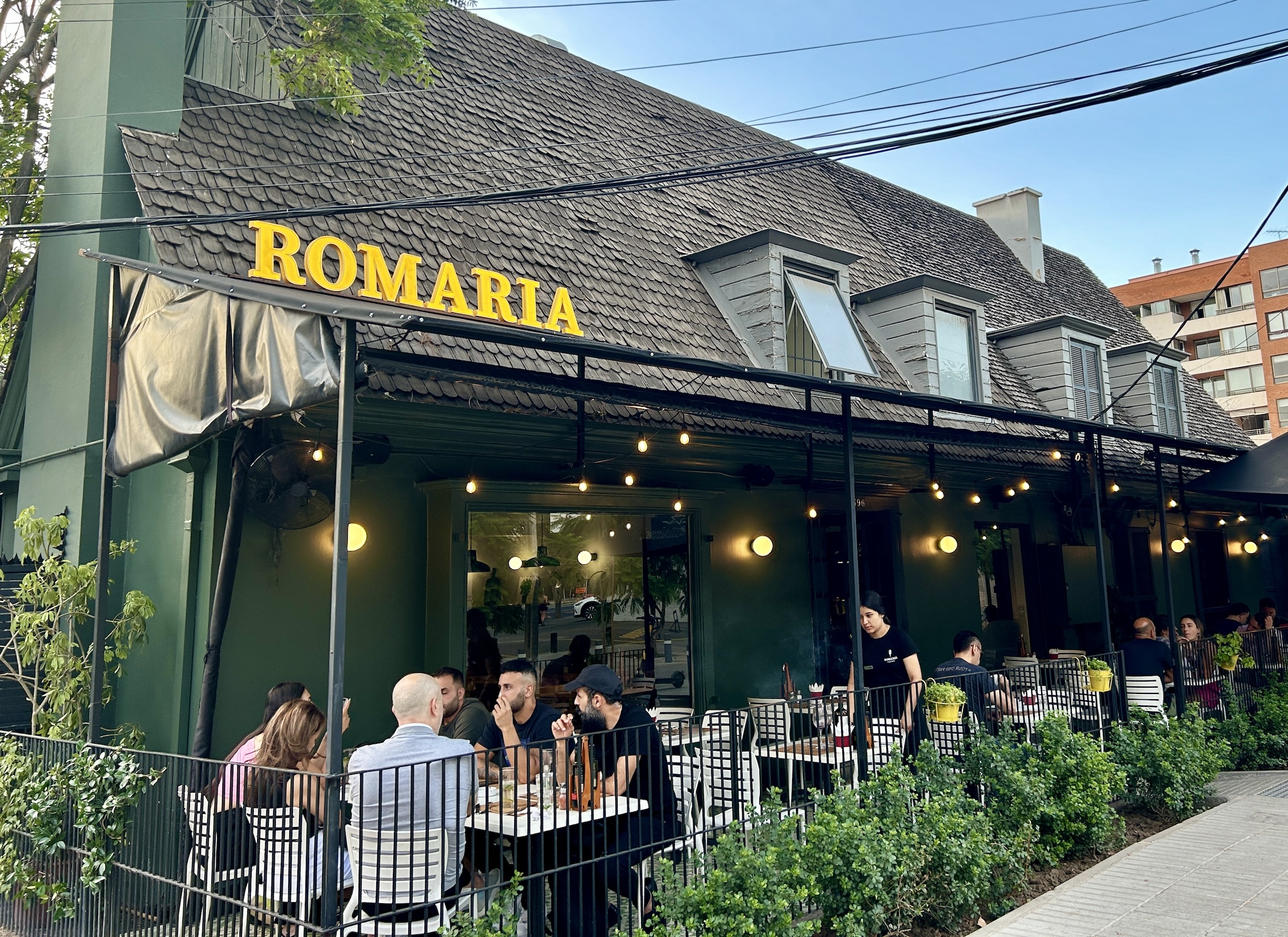 Romaria
Romaria
Romaria has no less than 31 varieties if pizza, but I opted for another of my staples, anything with Bolognese sauce.
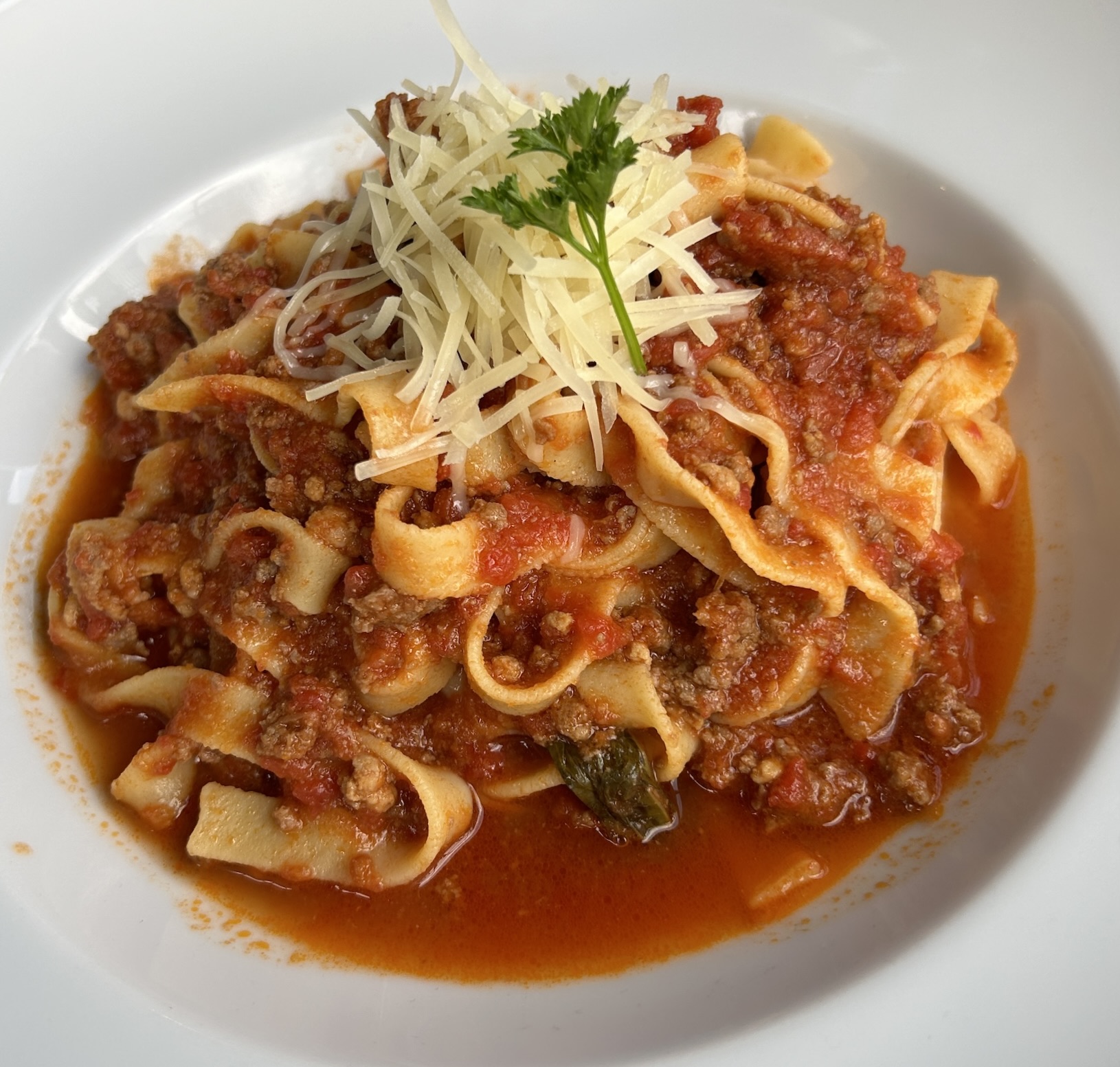
This was also the beginning of a beautiful romance. Here we shared our first bottle of carmenere in Chile. I had enjoyed this mild red wine in Canada, but trust me, what you get in Chile is off the charts compared to what gets shipped to Canada. This bottle was recommended by the waiter and was quite reasonably priced. Checking on line you can’t get this vintage it Canada, but in the UK it goes for $40 Cdn.
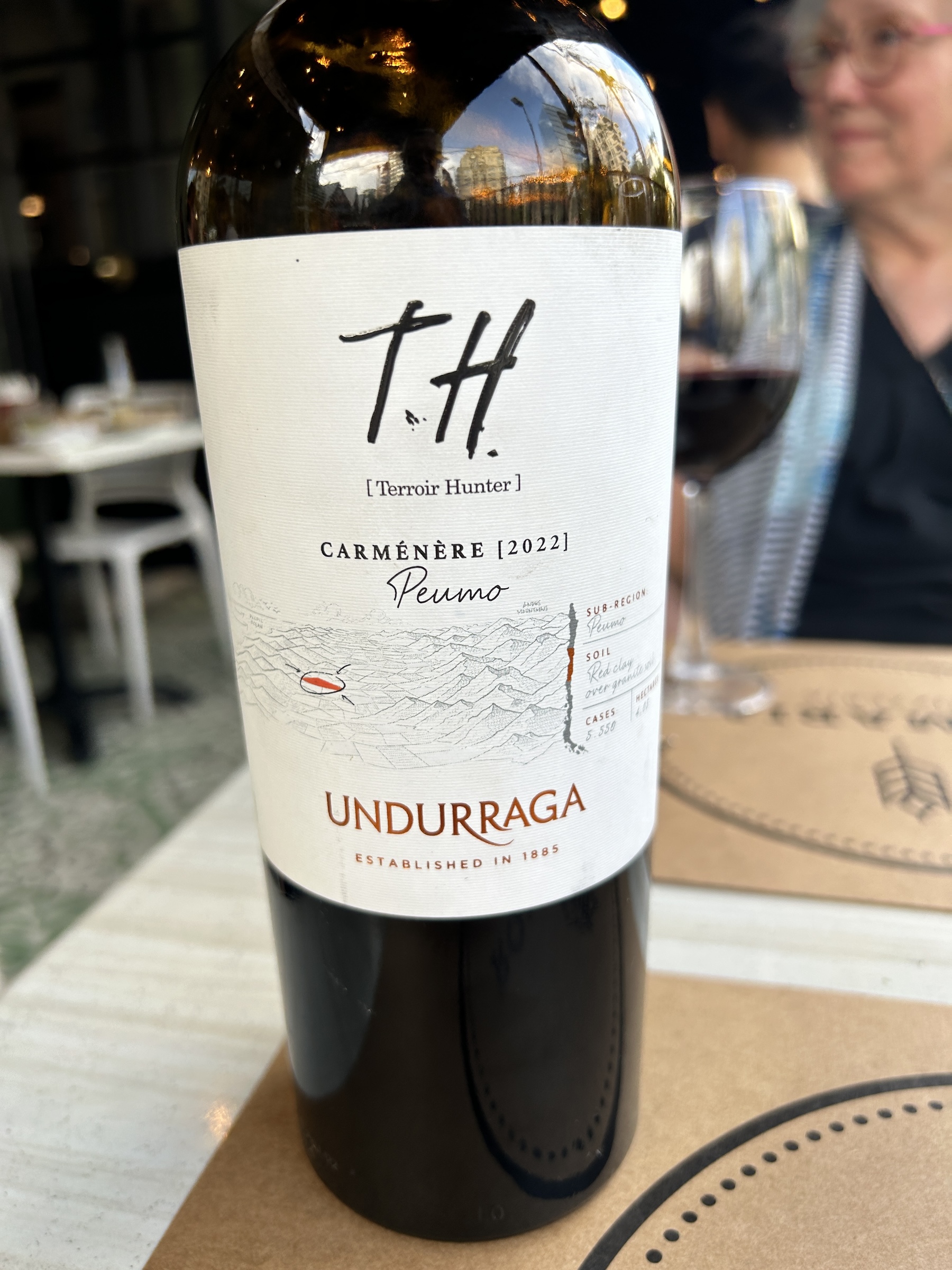
I had always assumed that carmenere was a native Chilean grape because you practically only find it in Chile, but it was originally French and got destroyed there by Phylloxera in the mid 19th century. Cuttings from Bordeaux that were described as merlot turned out to be the thought to be extinct carmenere, although it took over a century to figure that out. Today it is Chile’s signature wine and one we will enjoy many more times on this trip.
So our first day in Santiago has proven quite productive and after a good night’s sleep we will begin the tour in earnest with Chris Whatmore.
History of Santiago
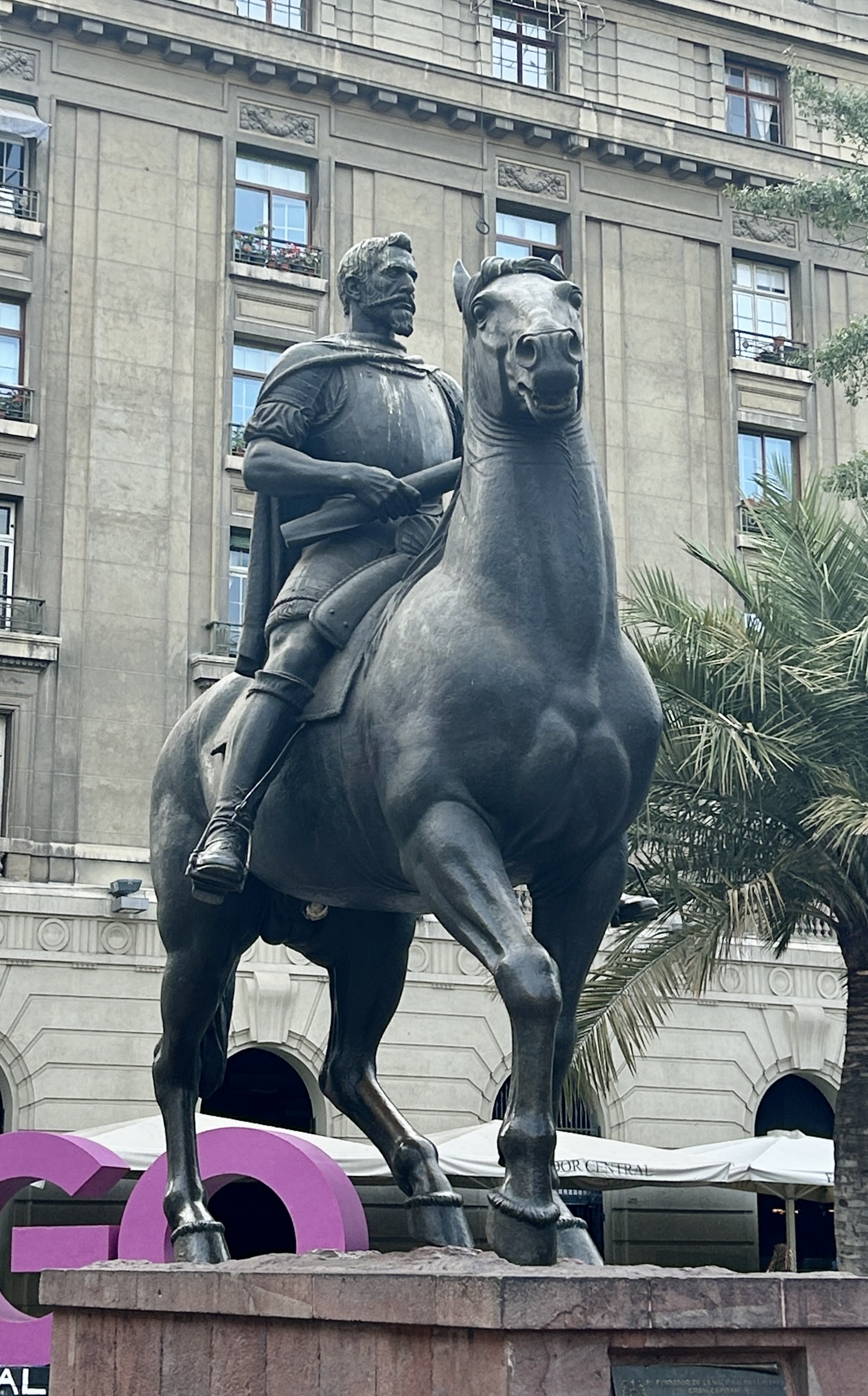
Santiago lies in the inland Maipo Valley some 100 kms. (62 miles) from the Pacific. It is surrounded on all sides by mountains with the Mapocho River flowing though the middle of it and has been occupied by humans for at least 10,000 years. The original hunter gatherers were replaced by farmers around 800. These people known as the Picunches came under the rule of the Incas during the late 15th century and the Santiago area became the southern terminus of the fabled Pacific Inca Trail that started at the modern Ecuador/Peru border. As the Incans had found out and the Spanish would in turn, moving further south into territory occupied by the Mapuche people would be met with fierce and effective resistance.
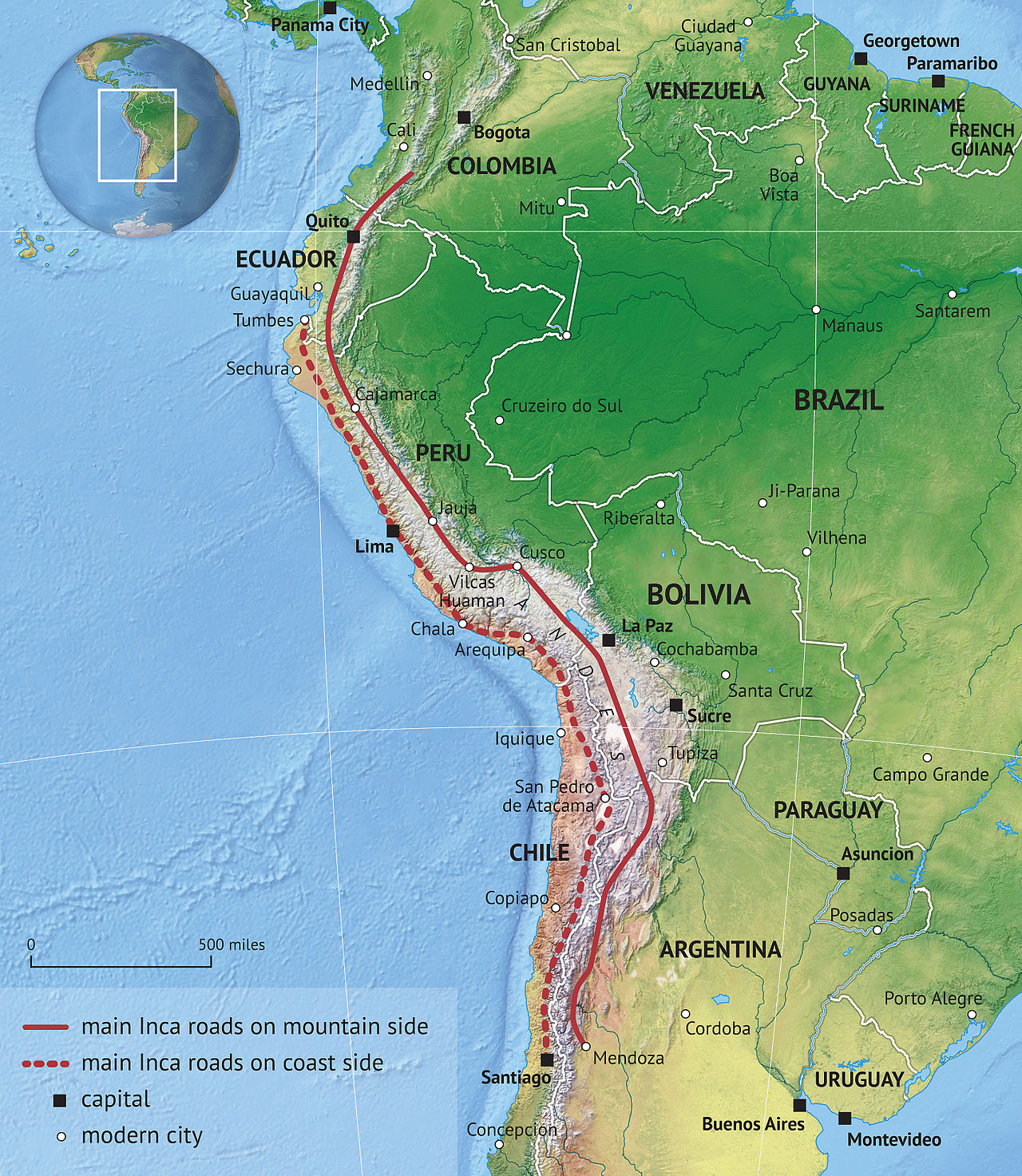
The actual city of Santiago was founded on February 12, 1541 by Pedro de Valdivia a subordinate of Francisco Pizarro who sent him south from Cuszo to explore and claim more lands for Spain. The original settlement was on Santa Lucia hill which we will visit later, and the city was laid out in a grid pattern by a trained Spanish architect. Despite numerous Indigenous uprisings, famine, plagues, floods and earthquakes, Santiago survived and eventually flourished. The centre of the Chilean government under Spanish rule was located around the Plaza de Armas and that’s where find the statue of Valdivia above and where we’ll start our tour of Santiago.
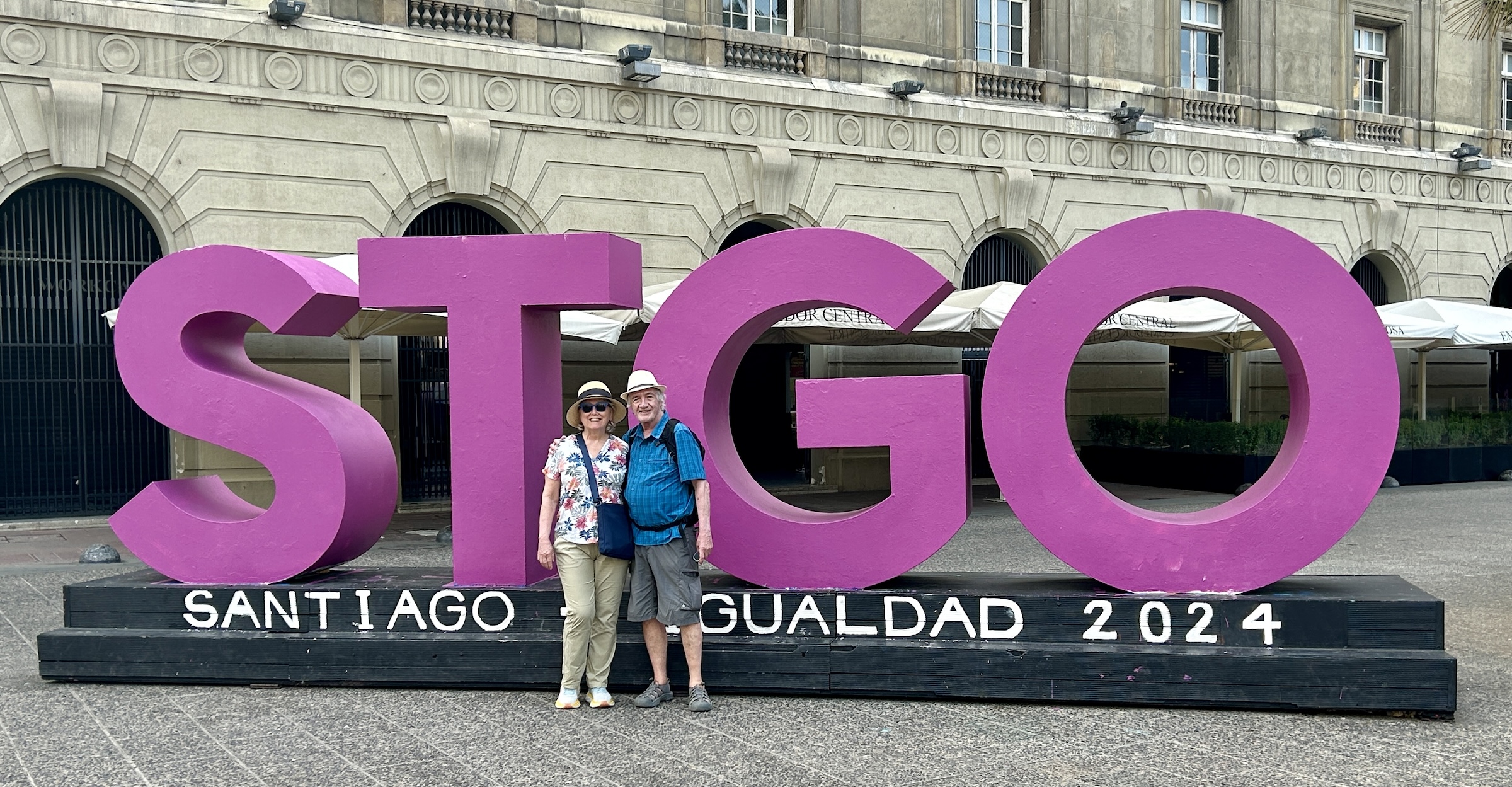
Plaza de Armas Area
The first thing to learn about Santiago is that it is not like many of its Latin American counterparts like Mexico City, Bogota, Quito or Antigua in that it has no great Spanish colonial historic centre; earthquakes took care of that. Instead its charms are more subdued and as Chris explains, to be found throughout the dozens of neighbourhoods that make up the city. If there is one focal point of the city then it is surely the Plaza de Armas around which you will find the Metropolitan Cathedral which is the fifth one built on the site and was only completed in 1906. While we visited Plaza de Armas with both Chris and more briefly on our Adventures Abroad tour, the cathedral was not open on either occasion so I can’t comment on the interior. By Latin American standards the exterior gets at C+.
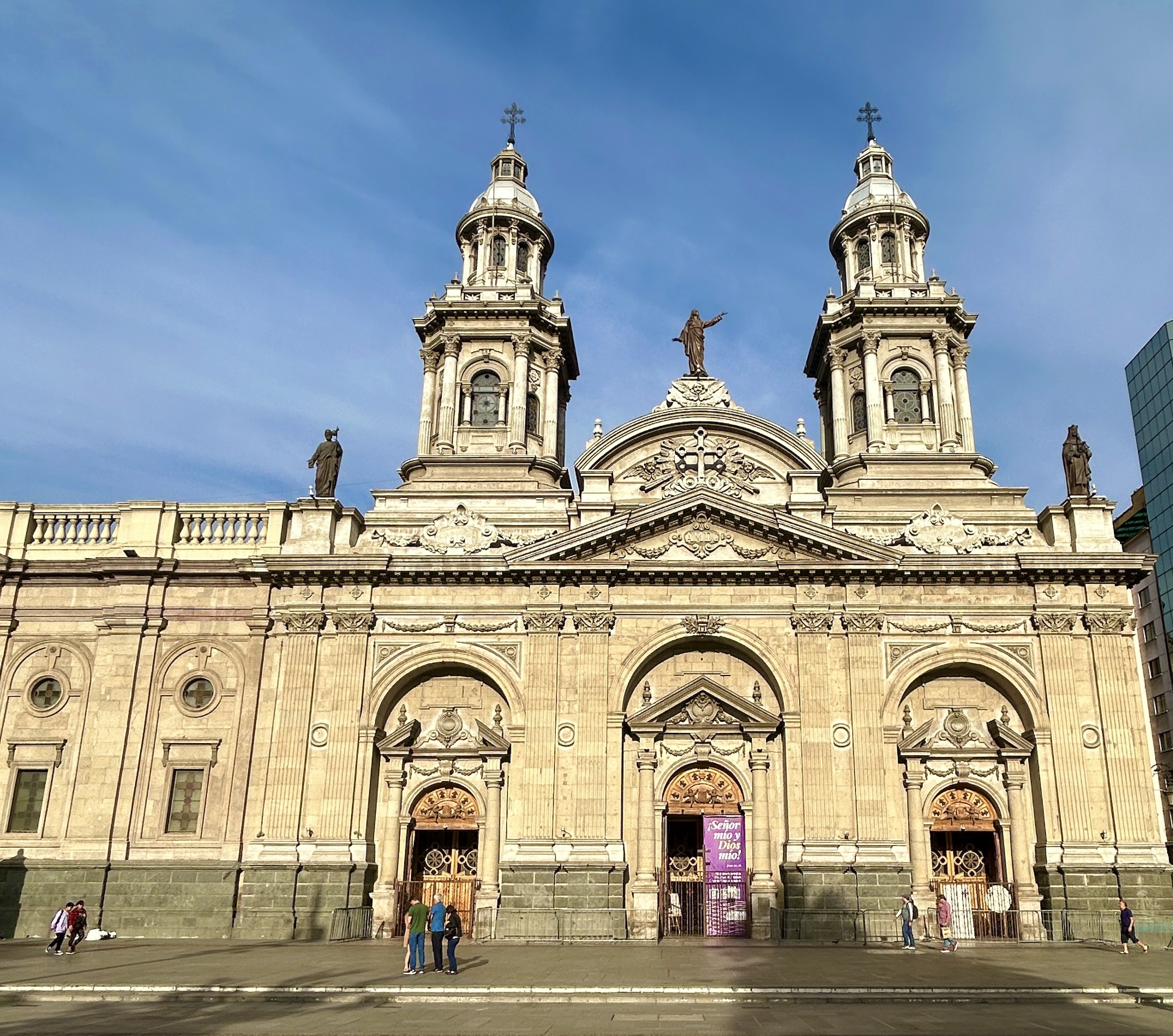
Other buildings fronting the Plaza de Armas include the Museum of National History which has eighteen galleries documenting Chile’s somewhat tumultuous path to the democratic country it is today. However, as Chris explains, this building was once the seat of the Spanish Royal Court and it was here in 1810 that the first attempt at overthrowing Spanish rule took place. While it was not successful, eight years later the Chilean Declaration of Independence was drafted here and it was the first meeting place of the newly independent congress of Chile. Thus you might call it Chile’s version of Independence Hall in Philadelphia and by coincidence both have a distinctive clock tower.
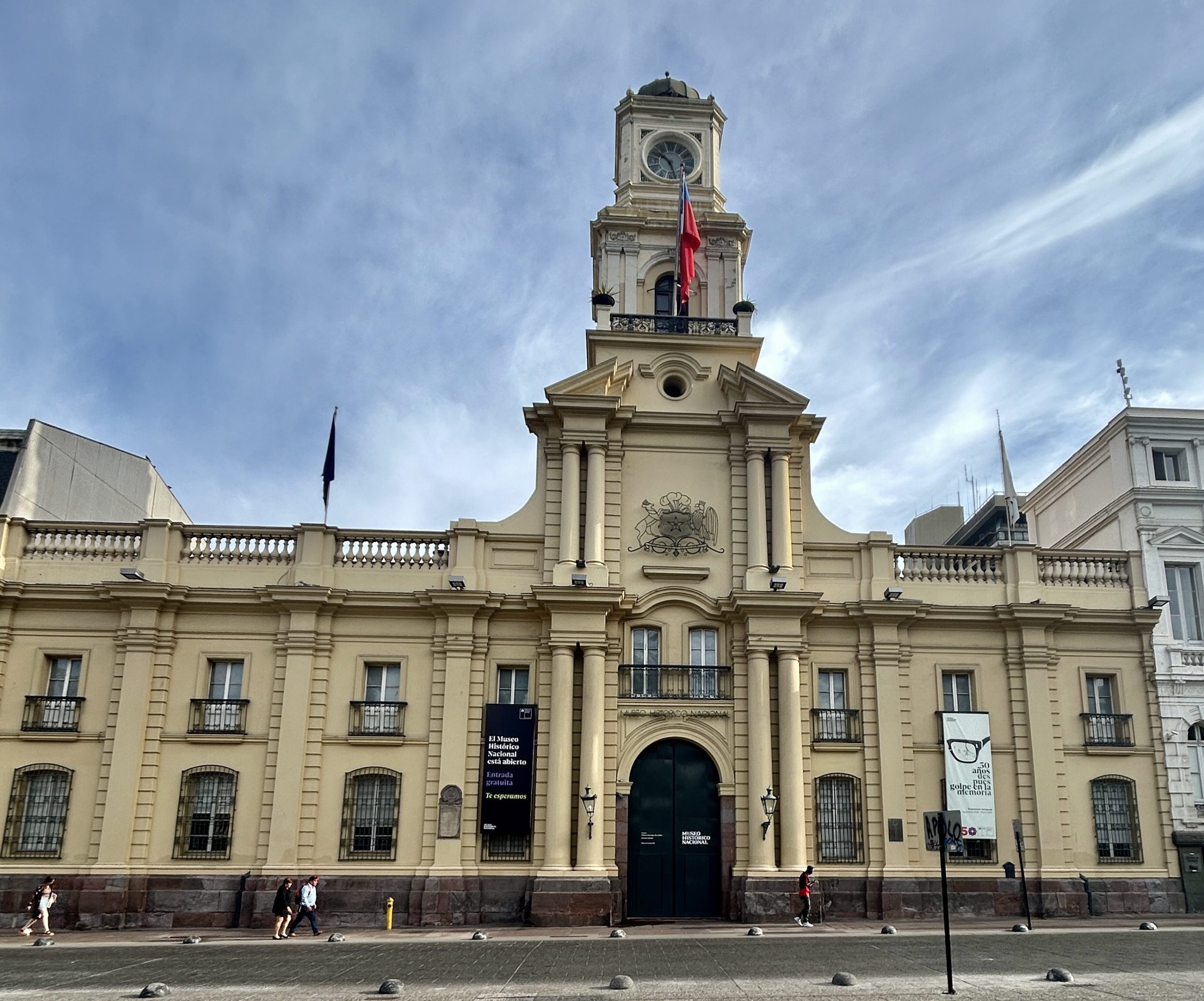
The Central Post Office is a Renaissance inspired building that dates from 1881 and is where you can mail your postcards back home, if anyone still does that.
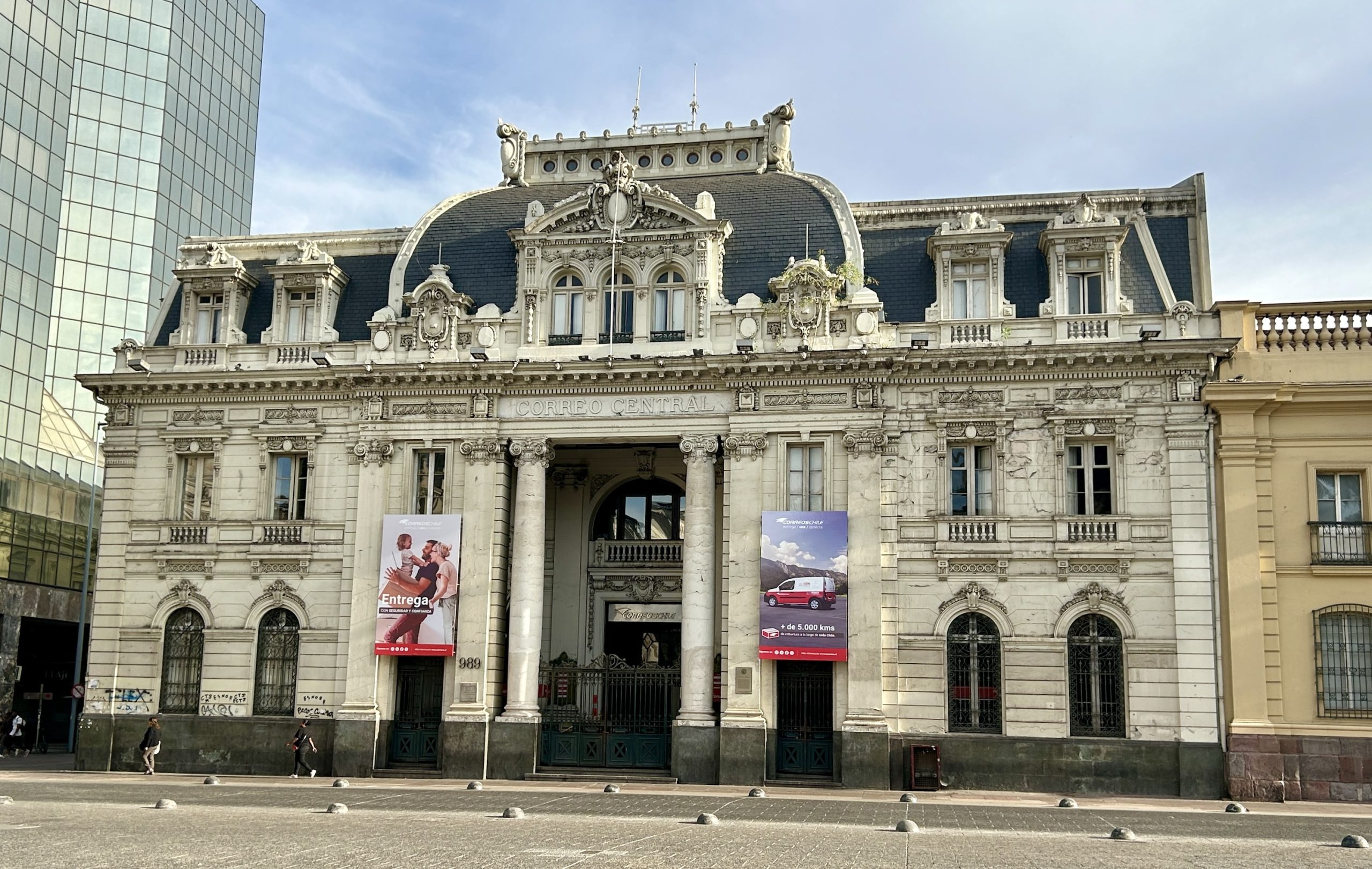
While Chile along with Uruguay is considered the safest country in South America, the one place you might want to be a little more alert is around the Plaza de Armas. It is in this area that émigrés who have fled from Venezuela, Haiti and other countries with oppressive governments are found in large numbers and unfortunately do engage in pickpocketing and other petty crimes. There are also a lot of obvious prostitutes. Everywhere we have travelled in Latin America we have seen the results of the Maduro government in Venezuela and the consequences it has had on all the other countries in the region which have been overwhelmed by Venezuelan refugees from what should be the richest country in South America. This makes for a good point to segue into probably the most controversial aspect of modern Chilean history, the Pinochet years.
Nearby the Plaza de Armas is the former National Congress of Chile with its grand neo-classical columns and pediment. This was the seat of the Chilean government from 1876 to 1973 with a few breaks to rebuild it after fires and earthquakes.
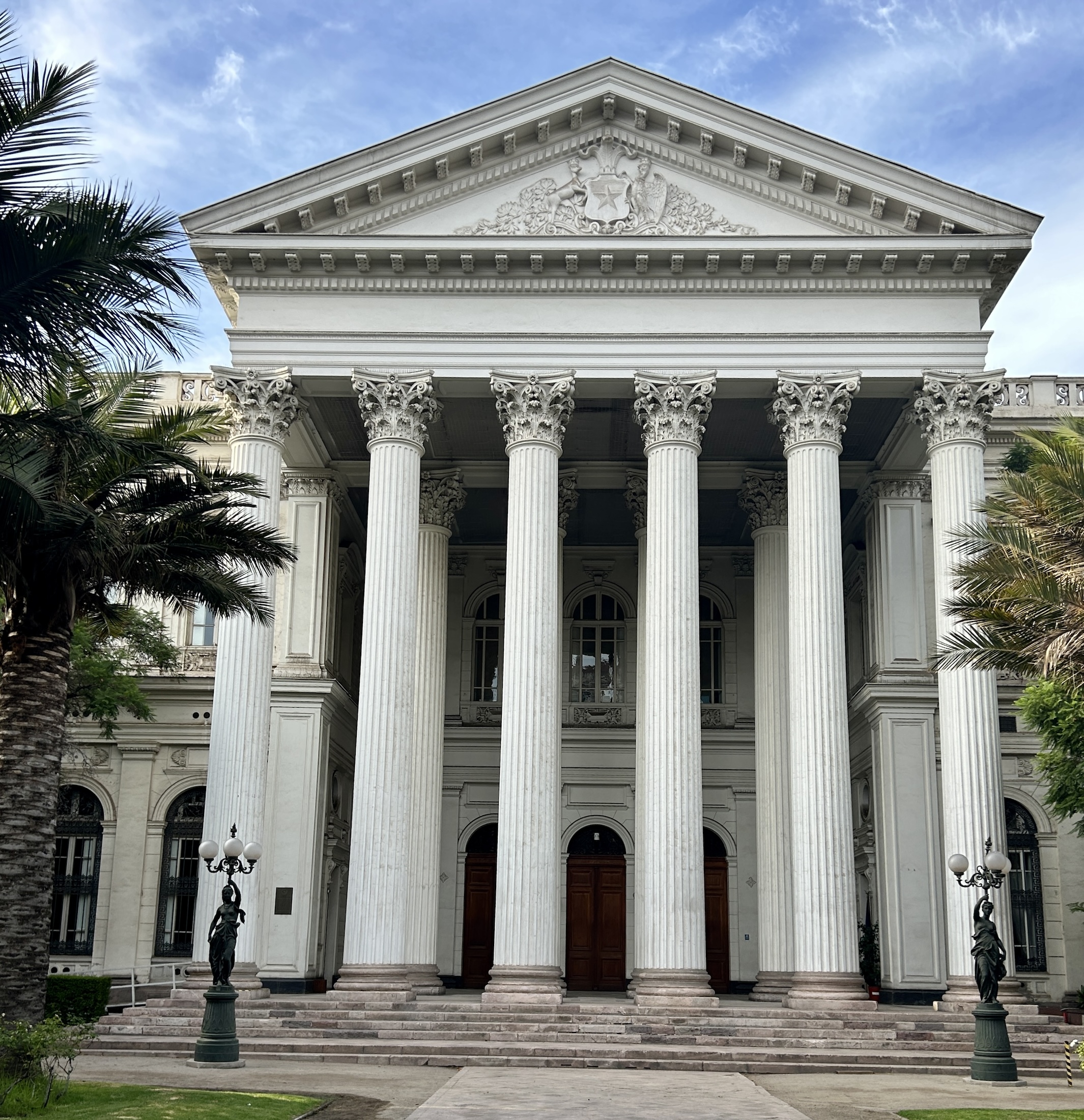
If you look closely at the pediment you can see the Chilean coat-of-arms which was actually designed by an Englishman, Charles Wood Taylor. It’s a good starting point for understanding Chilean history. On the right is the national bird and symbol of Chile, the Andean condor, a magnificent bird we have previously seen in Ecuador and hope to see again in this country. On the right is not a camelid like a llama or guanaco as you might expect, but rather a huemul, which is a mid-sized deer found in the Andes. Both creatures are wearing naval crowns representing the outsized role that the Chilean navy has had in protecting the country’s sovereignty in numerous wars with its neighbours. However, it was not a war with its neighbours that led to this building’s status as a former legislature, but rather an internal one.
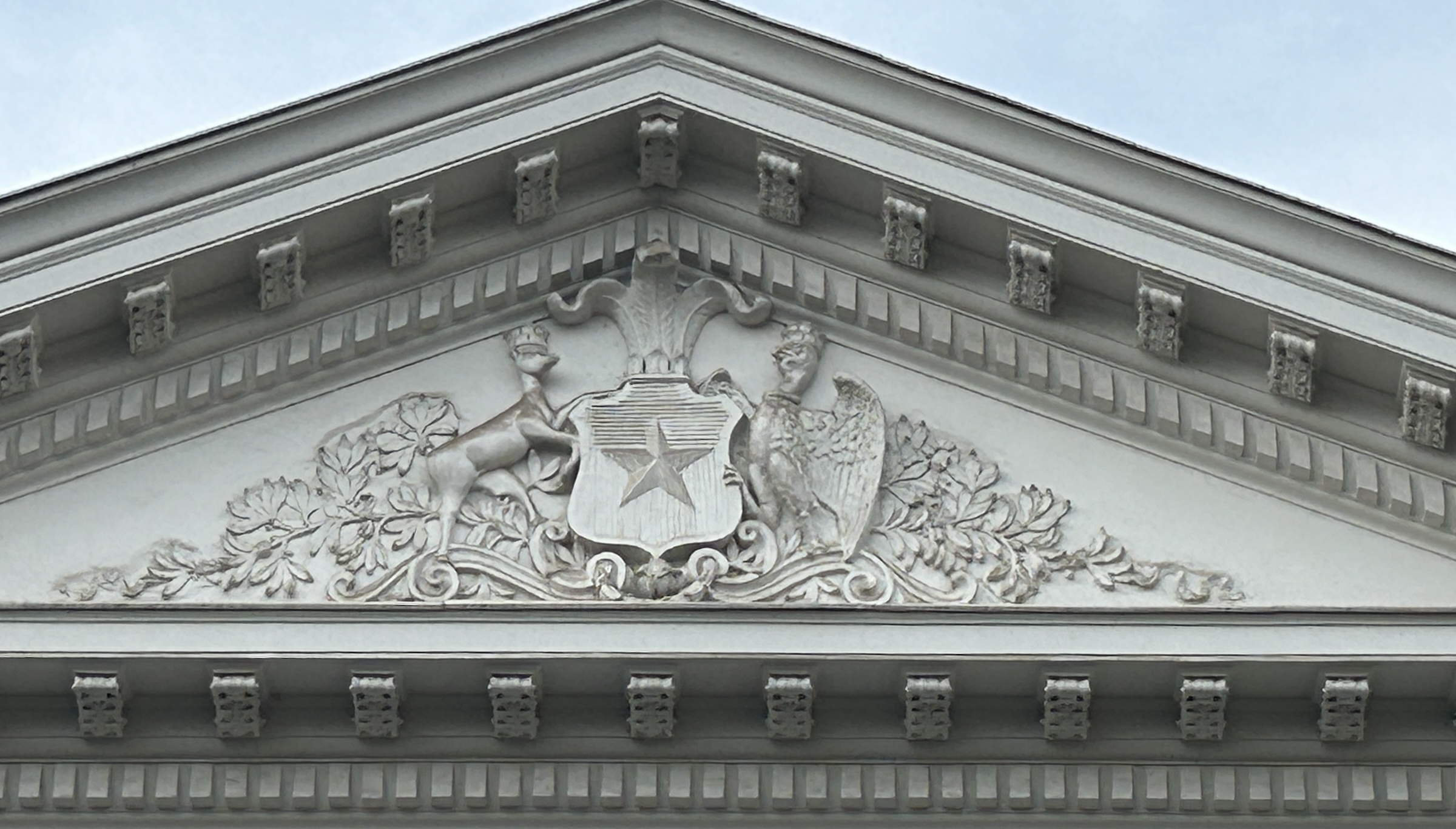
While the numbers 9/11 have a distinct meaning in North America referring to the September 11, 2001 attacks on the World Trade Center and the Pentagon, they have a different meaning in Chile. It was on September 11, 1973 that a military junta led by General Augusto Pinochet overthrew the duly elected government of Salvador Allende and ushered in a military dictatorship that lasted until 1990. The bicameral legislature that had met here for almost a century was dissolved and eventually relocated to Valparaiso which just happened to be Pinochet’s home town.
This is La Moneda Palace which was built as Chile’s first mint in the early 19th century and later became the Presidential Palace. It was this building that was attacked by the Chilean air force on September 11, 1973 with Salvador Allende inside. The building was virtually demolished and Allende’s body found inside, dead of an apparent suicide – or maybe not. The answer is still unclear. The palace has subsequently been rebuilt and is once again where the President of Chile’s office is located as well as several other cabinet departments.
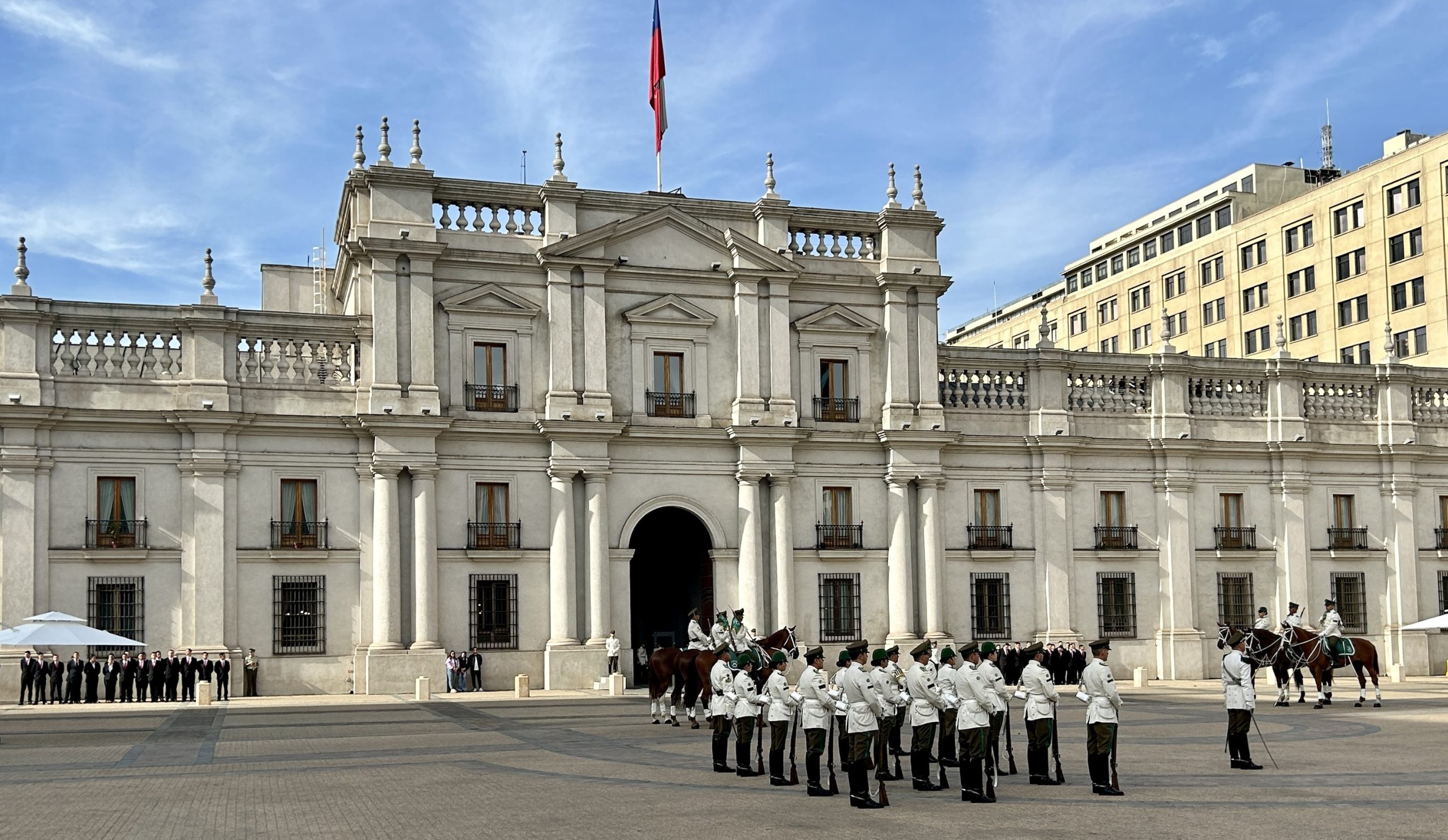
By chance we arrived at the changing of the guard which is accompanied by a military band playing My Way and a few other decidedly unmartial tunes. The many spectators, including many kids and dogs, were enjoying the pageantry as were we. Here’s a short video of part of the proceedings.
Now here’s the thing about Allende and Pinochet that we don’t hear much about outside of Chile. The standard view is that Allende was the darling of the people and that Pinochet was an old school militarist who couldn’t abide change. It is true that Pinochet was a bastard who had people killed and tortured unnecessarily. What is also true is that Allende’s rapid and incompetent economic changes were destroying the country and it was headed in the same direction as Venezuela and Nicaragua after they elected populist left wing regimes. The reality is that the period of dictatorship did stabilize the economy and snapped Chile out of an increasing cozy relationship with Cuba, the USSR and China. The constitution that Pinochet brought in is still the governing document and efforts by both left and right wing factions to replace have both failed. Pinochet was undoubtedly guilty of crimes against humanity, but Allende was no saint either and if left unchecked Chile might have become a basket case.
Nearby the Plaza de Armas is Santiago’s Mercado Central which is one of the largest seafood markets you’ll find anywhere. With 6,000 kms. (4,000 miles) of Pacific coastline Chile has an abundance of seafood and a greater variety of species than I have ever seen at a market. For me this was be a must see destination in Santiago. It was clear that this is not a tourist market. Any tourists like us were busy watching the locals go about their purchases. This is just one of many photos I took and shows that the market is selling fish, mollusks, octopi, crabs, shrimp and pretty well anything you could wish to eat from the sea.
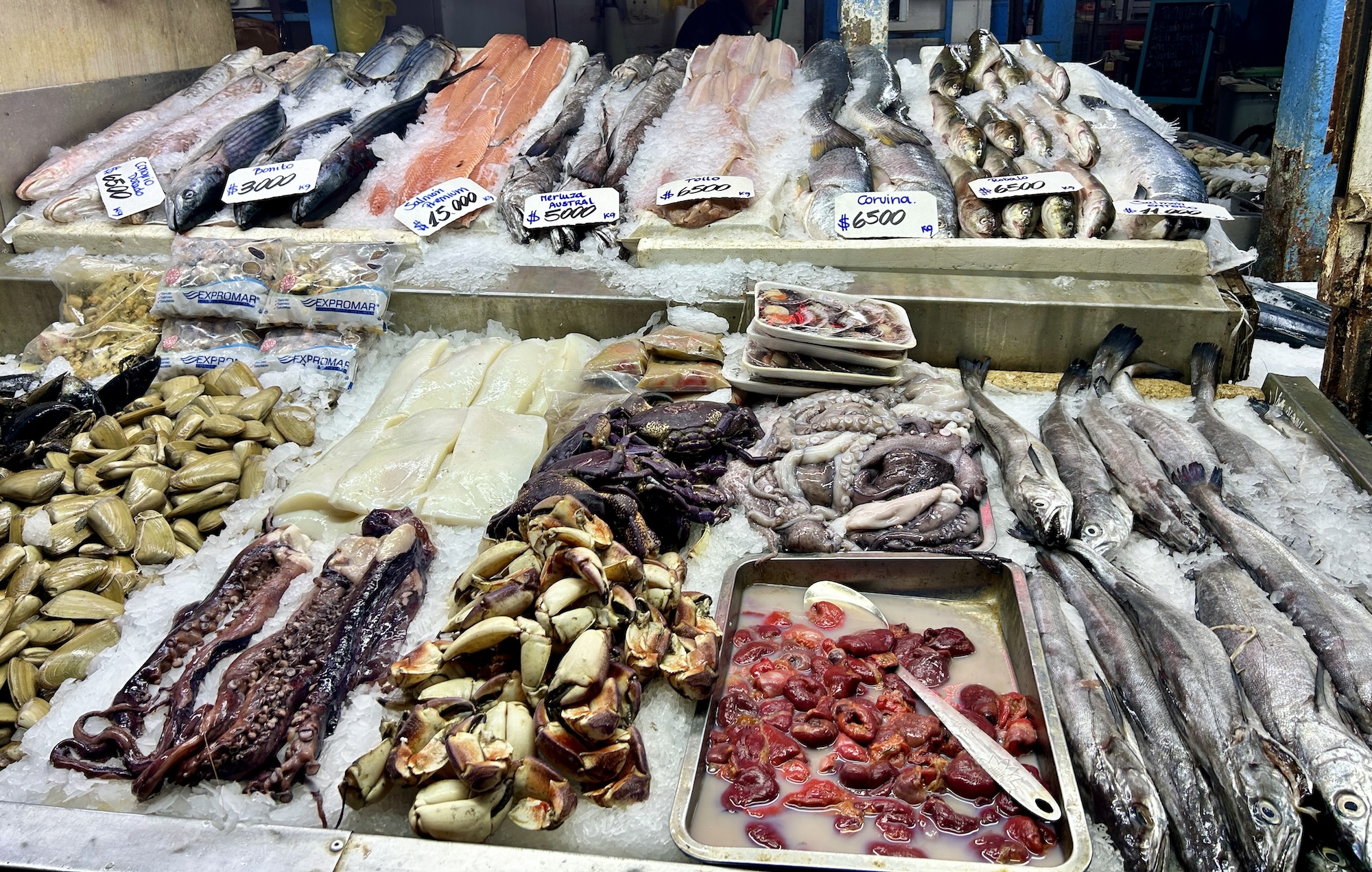
There are two long established restaurants in the Mercado Central where people from all over the world come to indulge their passion for seafood and later on this trip Alison and I will return to do just that.
While we didn’t buy any seafood, Alison did purchase a small bag of Chilean merken seasoning which is made from dried smoked chiles, coriander and other spices that is used in meat, fish and poultry recipes. She always tries to get her hands on these type of local specialties that are unlikely to be found in our part of Canada.
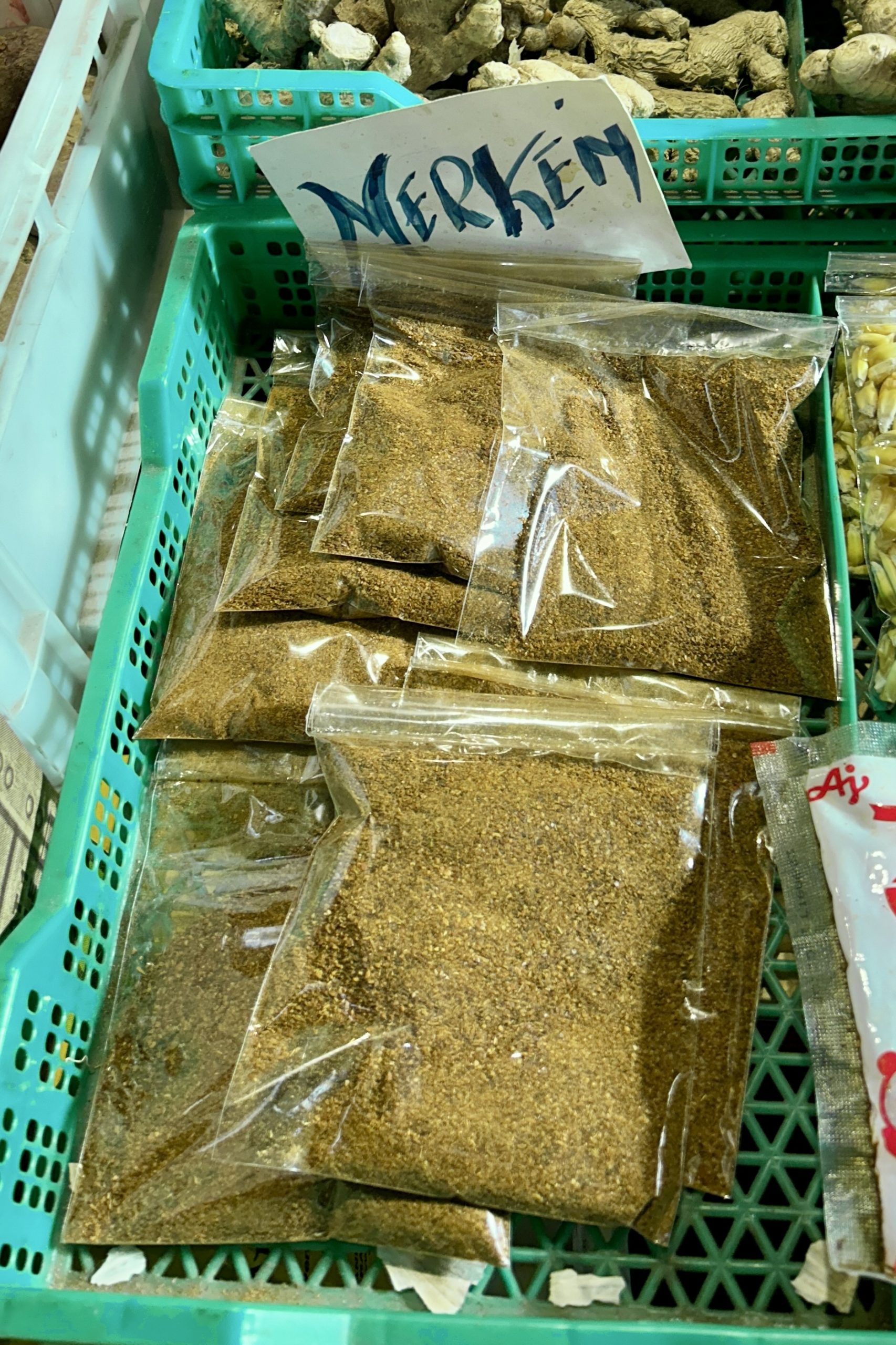
After a good couple of hours in the Plaza de Armas area we got back into Chris’ van and headed for the oldest part of Santiago, Cerro Santa Lucia with one short stop along the way at the historic Club Hipico de Santiago which is the oldest race track in Chile. It was recently the host of the Gran Premio Latinoamericano, the richest stakes in Latin America. The trainers were out with their horses and these two stopped by to chat as they passed by.
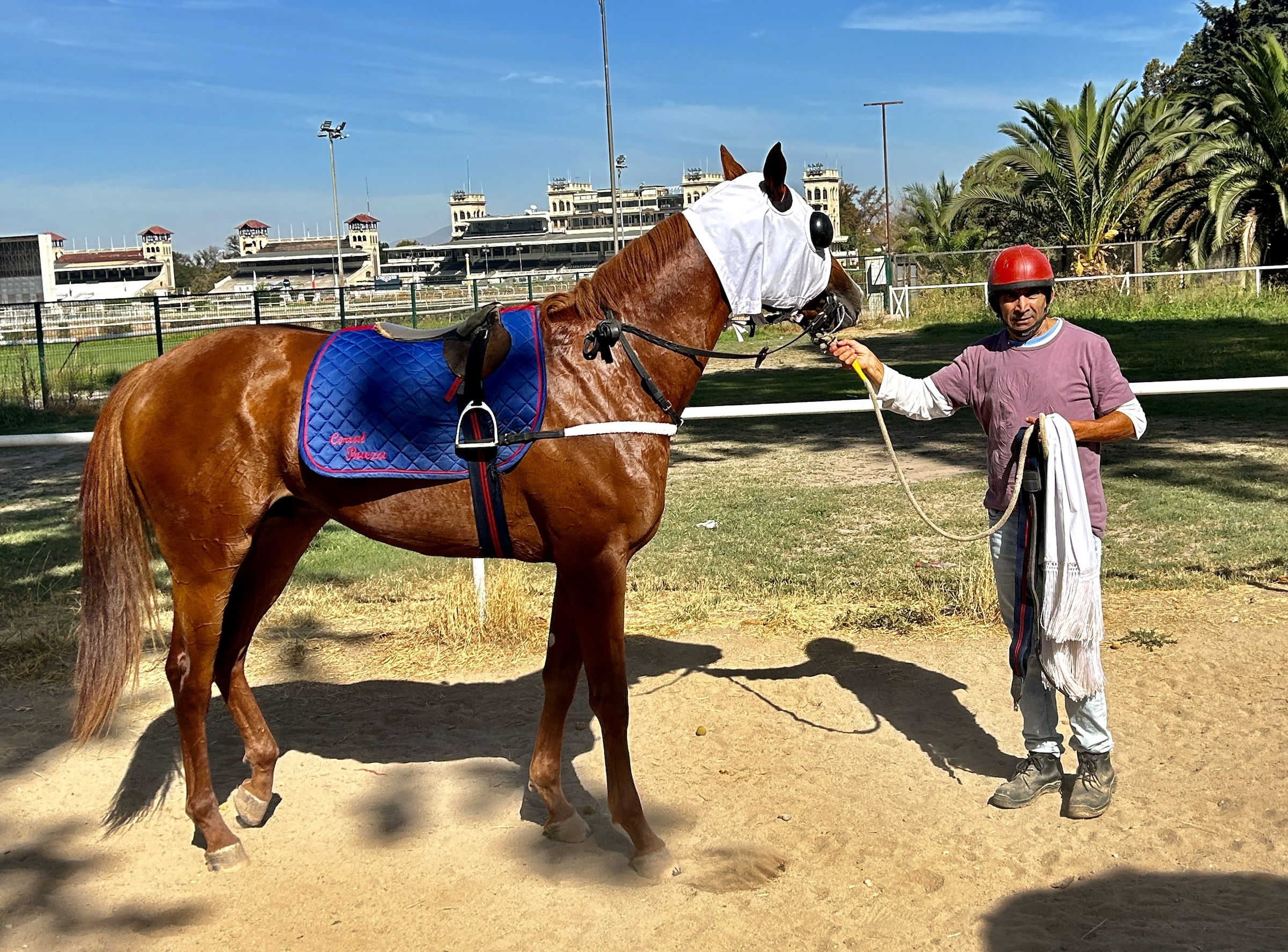
Cerro Santa Lucia
This small volcanic hill, only 69 metres (226 feet) high is where Pedro de Valdivia declared the foundation of Santiago and from where the conquistadores were able to build a fortification to successfully fend off attacks by the original inhabitants who weren’t too happy with these latest trespassers. Ordinarily you need to park your vehicle at the bottom of the hill and walk up, but Chris had a guide’s permit that allowed him to take us to the upper parking lot. The steps would have been doable, but it was 31°C (88°F) so skipping them didn’t make me feel guilty.
At the top are two wooden statues known as chemamulls which were erected by the Mapuche people to mark the graves of people who had distinguished themselves during their lifetimes.
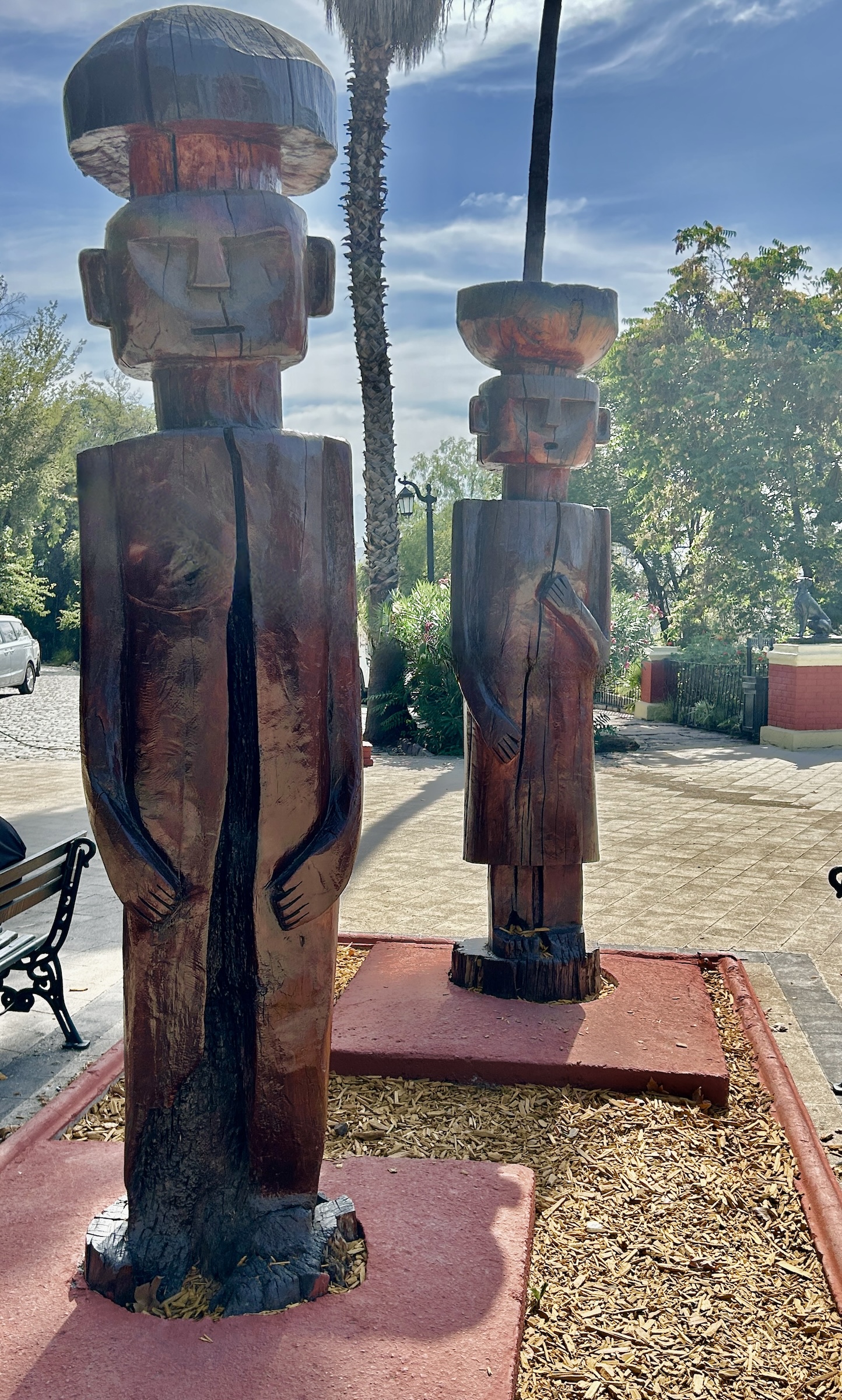
At the top there is also this statue of an Indigenous warrior that has an amazing history. Before getting into it, you need to know about the history between the Mapuche people of southern Chile and the Spanish. Every war between whites and Indigenous peoples seems to have one outcome – the natives lose. However, in the case of the Mapuche this did not happen. For 260 years they successfully resisted Spanish attempts to conquer them and peace only came after Chile became independent. One of the great leaders of the Mapuche was Caupolican who was responsible for the death of Pedro de Valdivia in 1554. The statue below is erroneously believed to be a depiction of Caupolican, but it has a far more interesting story.
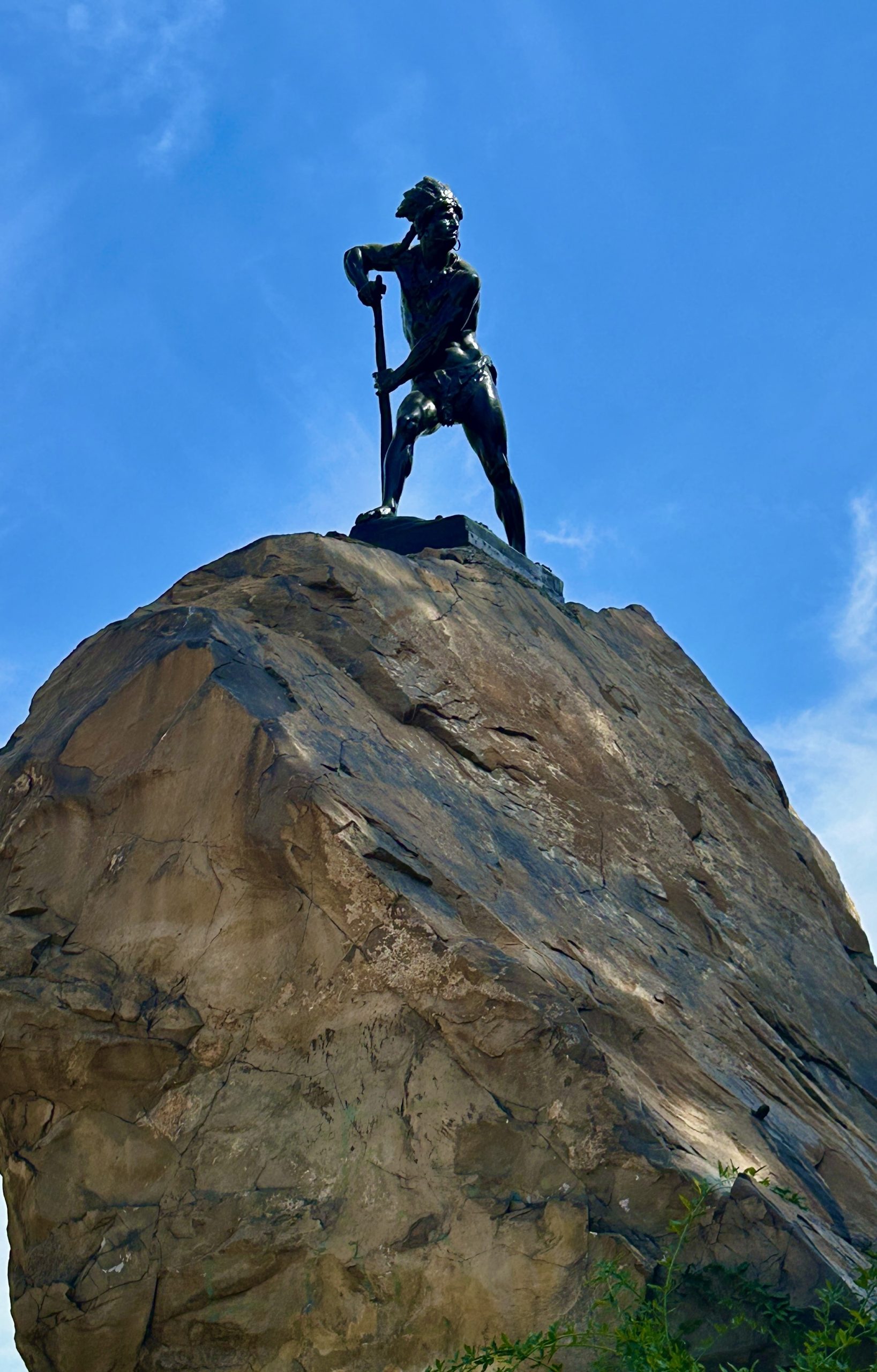
If you go online and type in “Last of the Mohicans sculpture” a figure identical to that above will come up. This statue was originally made by Chilean sculptor Nicanor Plaza at the request of the American embassy in Santiago in the 1860s. It was intended to be a statue of Caupolican, but Plaza, who was living in Europe, had no idea what Caupolican looked like so he copied a print from James Fenimore Cooper’s Last of the Mohicans. Ironically the print was of Natty Bumppo who was actually a white man. The Americans recognized a phoney when they saw one and refused to pay for it. Plaza eventually did get the Chilean government to purchase it and install it where it is today and to pretend that it is Caupolican. So you have a white guy dressed as a Mohican subbing for the real deal.
You can walk up to the very top of Cerro Santa Lucia via a somewhat precipitous stairway which Alison elected to avoid The reward is some great views over Santiago. The large building directly below is the National Library of Chile.
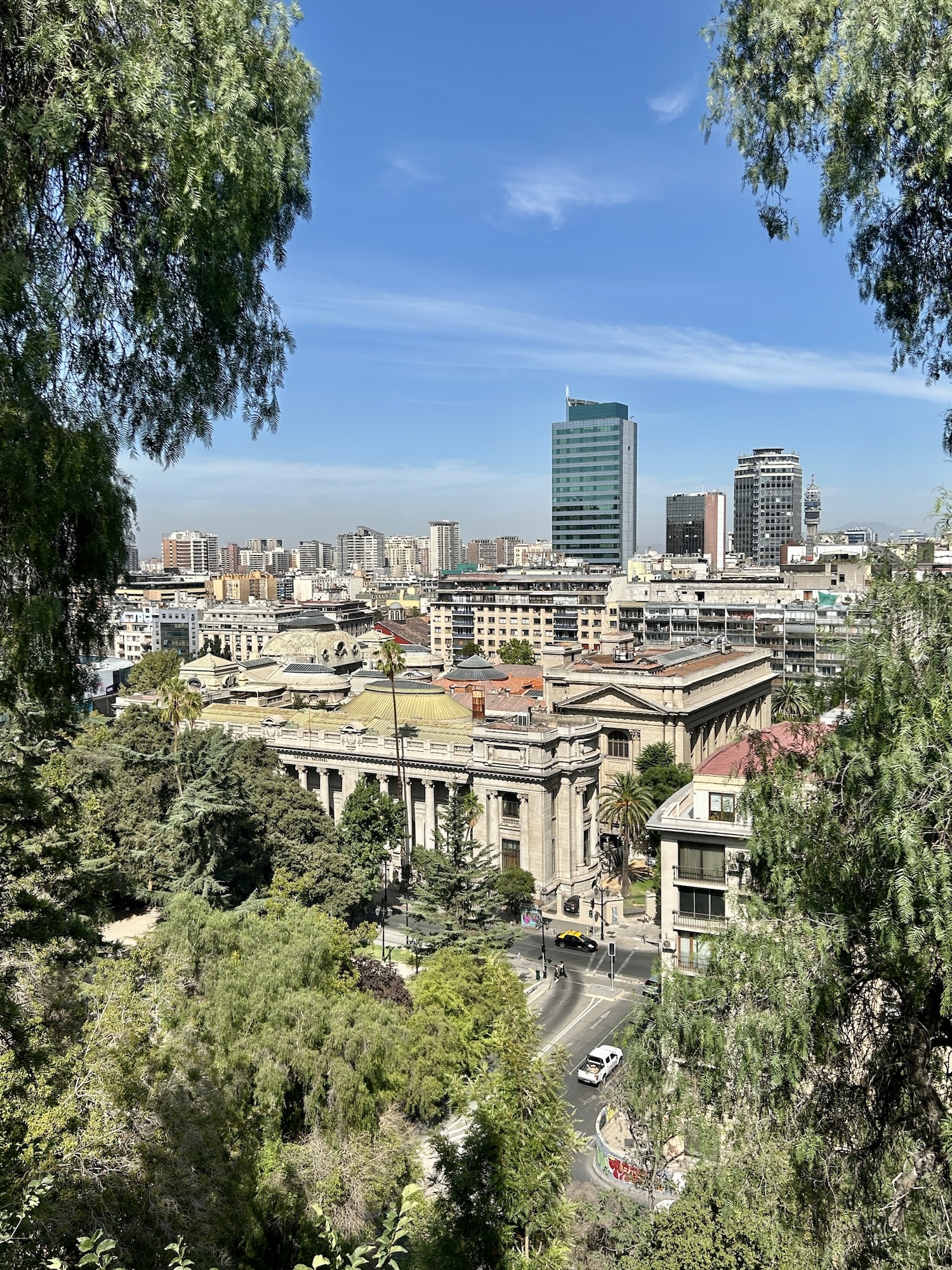
I got Chris to take this photo as a memento of this place.
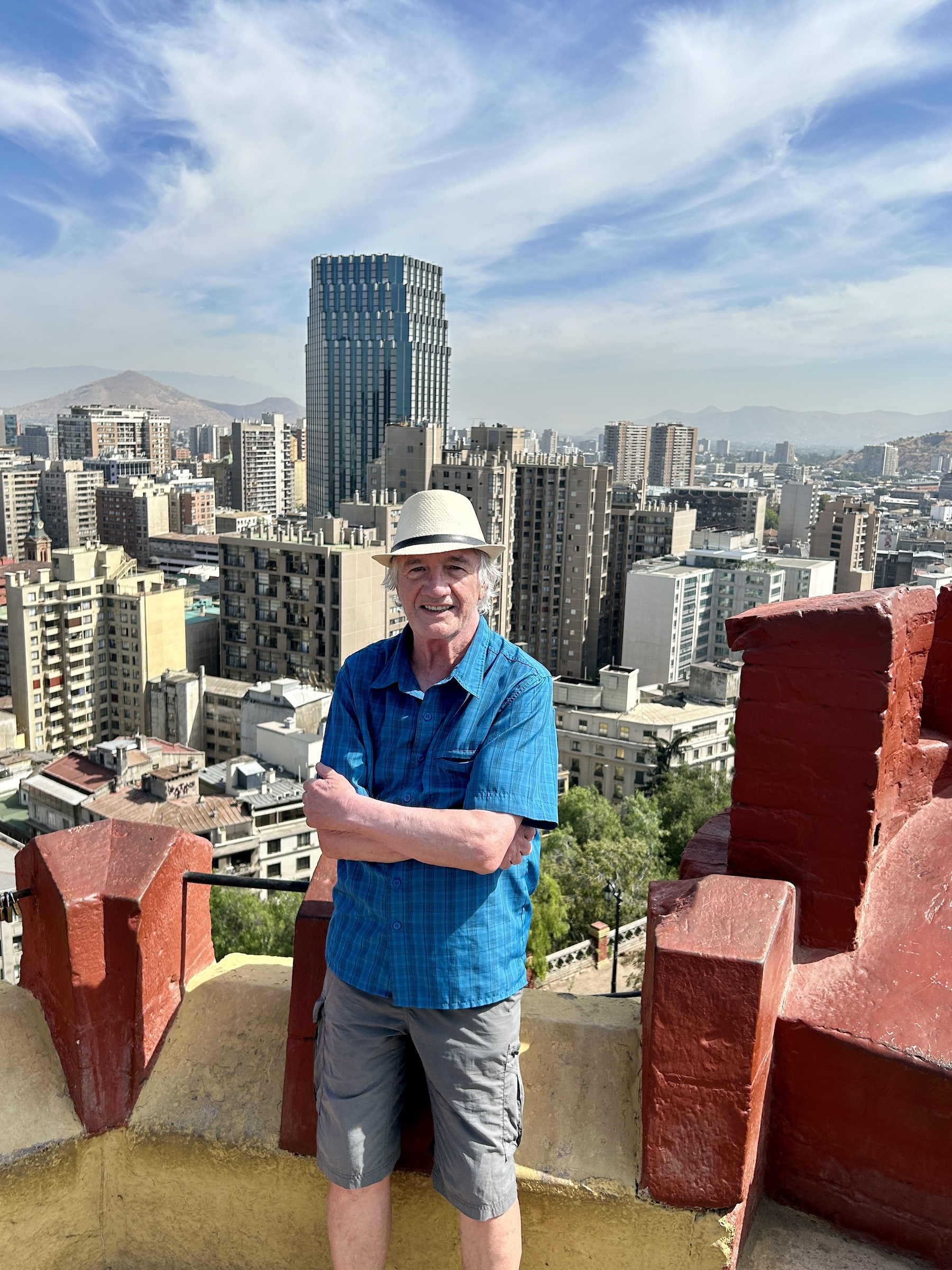
Cerro San Cristobal, Santiago
If there is only one thing you could do in Santiago I would suggest that it is taking the teleferico (aka the Santiago Cable Car) to the top of Cerro San Cristobal. This hill is much higher at 300 metres (984 feet) than Cerro Santa Lucia and is host to Santiago’s largest park, the Metropolitan. Within it you will find the National Zoo, a Japanese garden, several public swimming pools and miles of walking paths. However, the main attraction is undoubtedly the huge statue of the Virgin Mary that is at the very top. You can reach it by walking, taking a funicular or by way of the cable car. One good option is to take the funicular or cable car up and then walk down. We didn’t have the time for this so it was up and down by the teleferico. This is what most people come here to see, although the views of Santiago from here are pretty splendid as well.
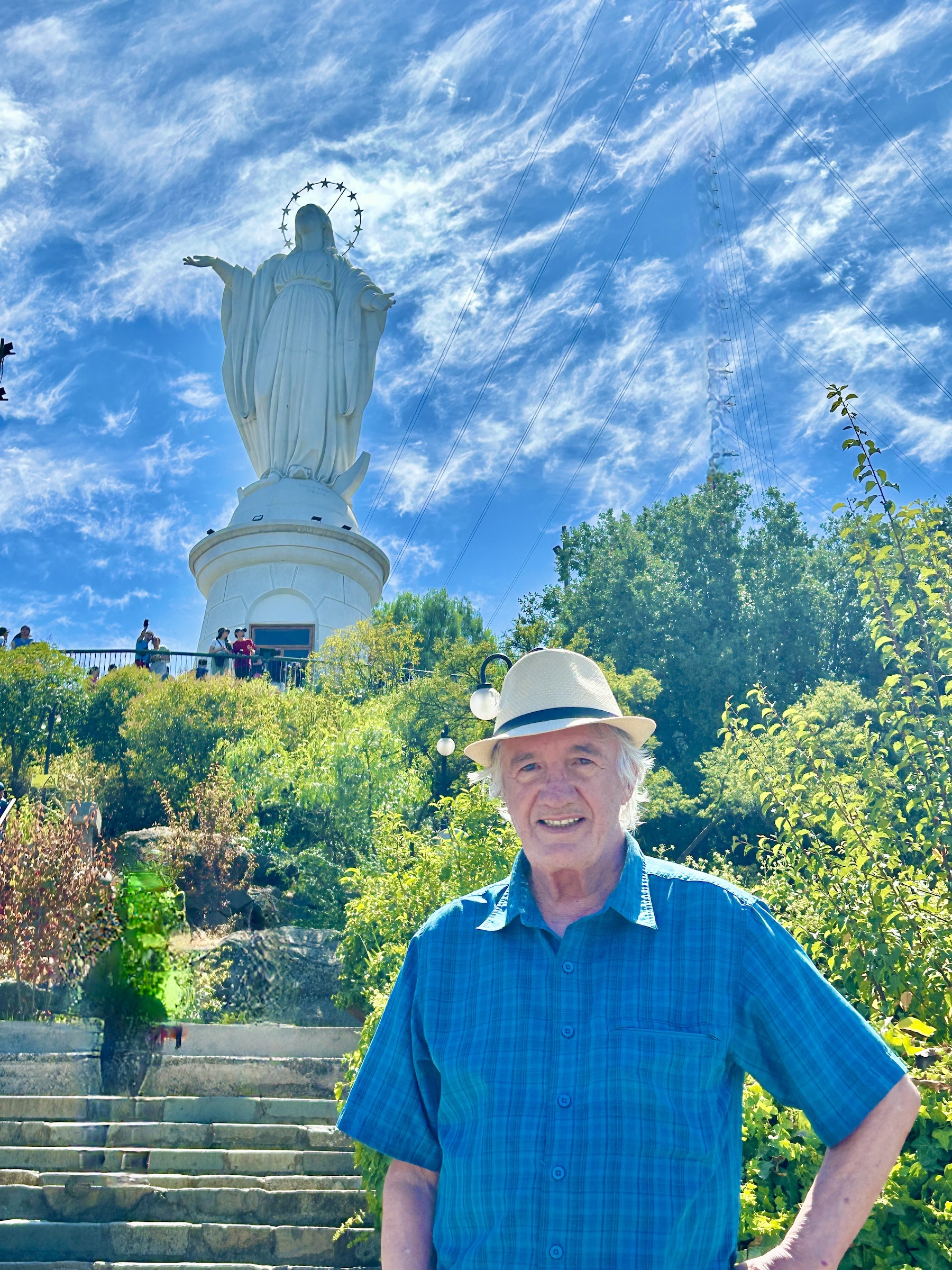
Taking a closer look the Virgin almost appears to have a natural halo around her head.
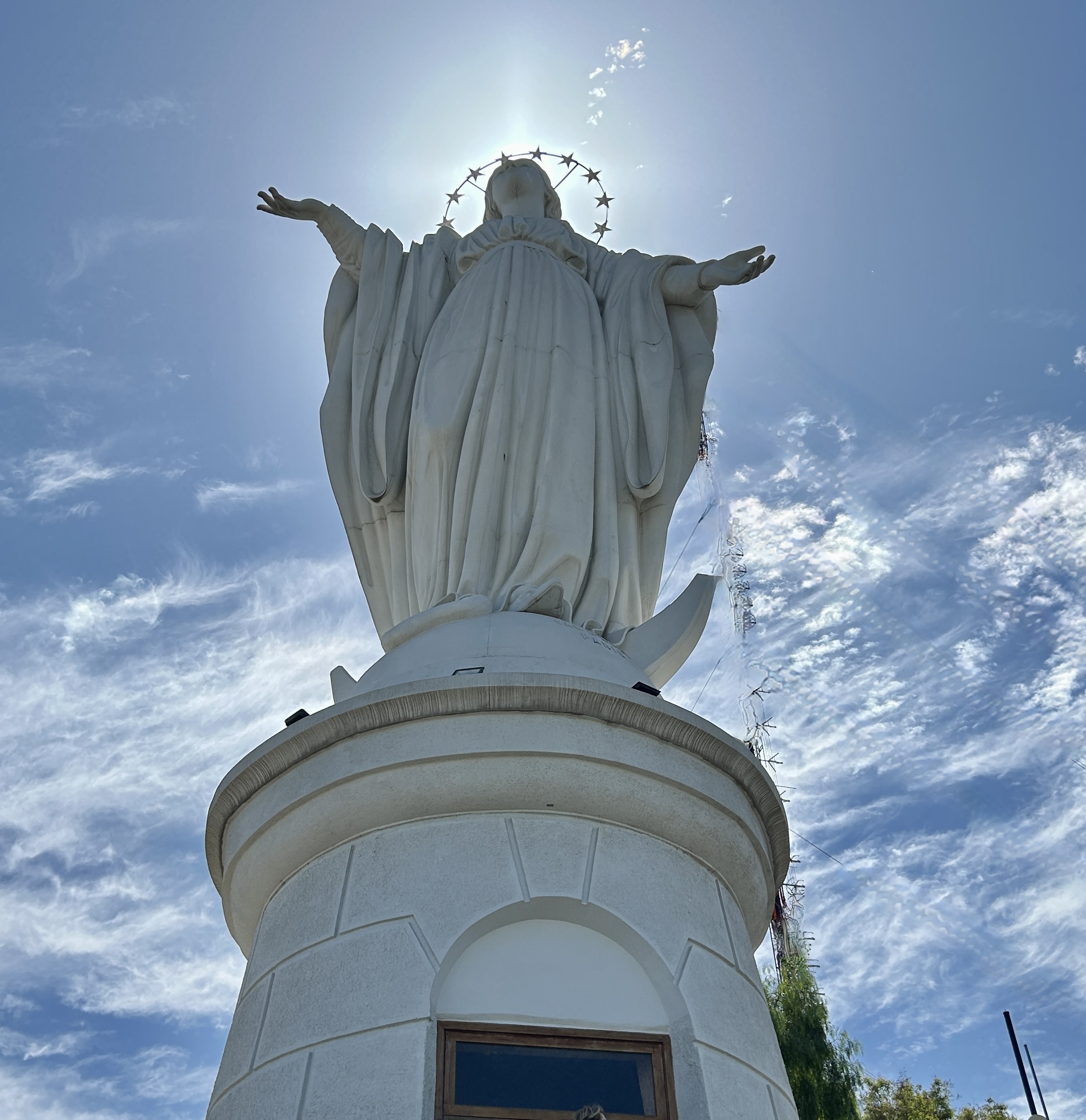
By now it was time for lunch and Chris drove us to the very upscale neighbourhood of Las Condes which is leafy, modern and home to the Canadian Embassy which we passed on the way to Espacio Urbano, a large outdoor area with a ton of shops and restaurants. For some reason we both felt like a good cheeseburger and found that at Uncle Fletch which is modelled on an old Texas railway station.
Chris had made some suggestions on great Chilean beers and I enjoyed a Kross Golden Ale draft, in fact two of them.
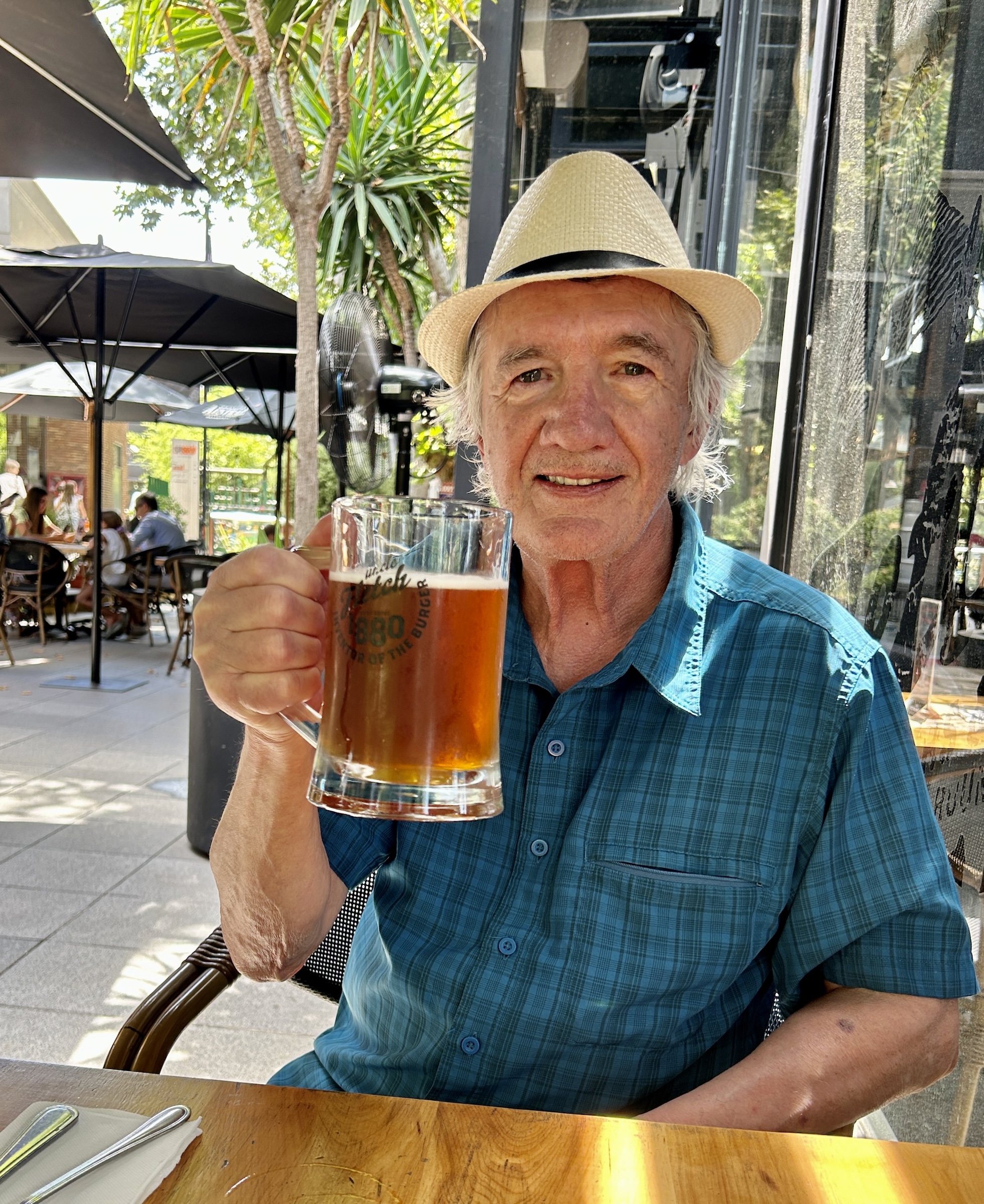
And the burger and fries were just what I needed to accompany it. Now lest you think I’m one of those traveller’s who always seeks out ‘safe’ choices, this was the only burger I had in the three weeks we were in Chile. It was so good I didn’t need another.
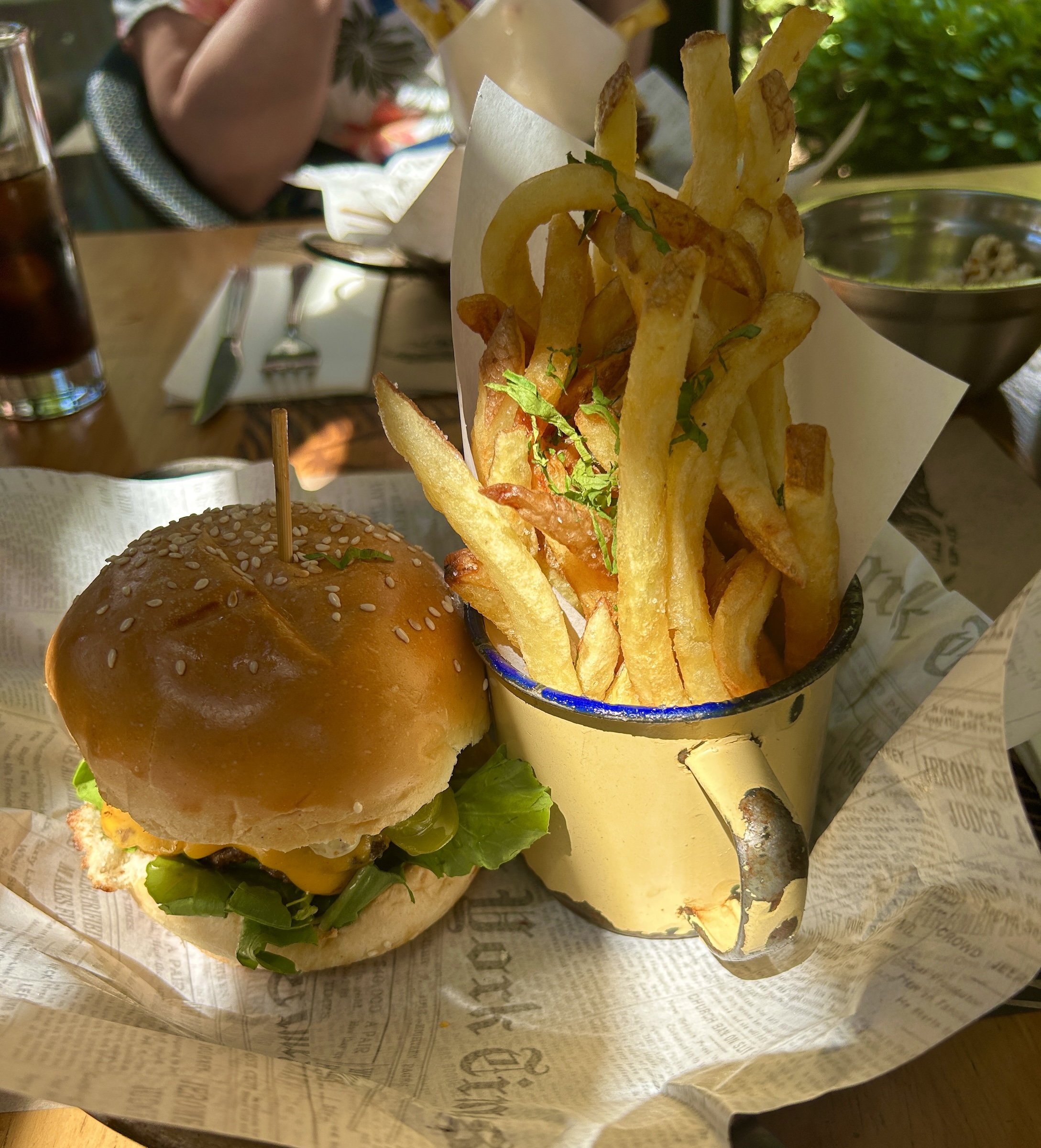
Our final stop on the tour with Chris Whatmore was at a small wine store where he bought his wines. The owners knew him and helped us pick out a Cabernet Saivignon, a Carmenere and Kunstmann Pale Ale, all at very affordable prices. These turned out to be wonderful wines and the beer was great as well.
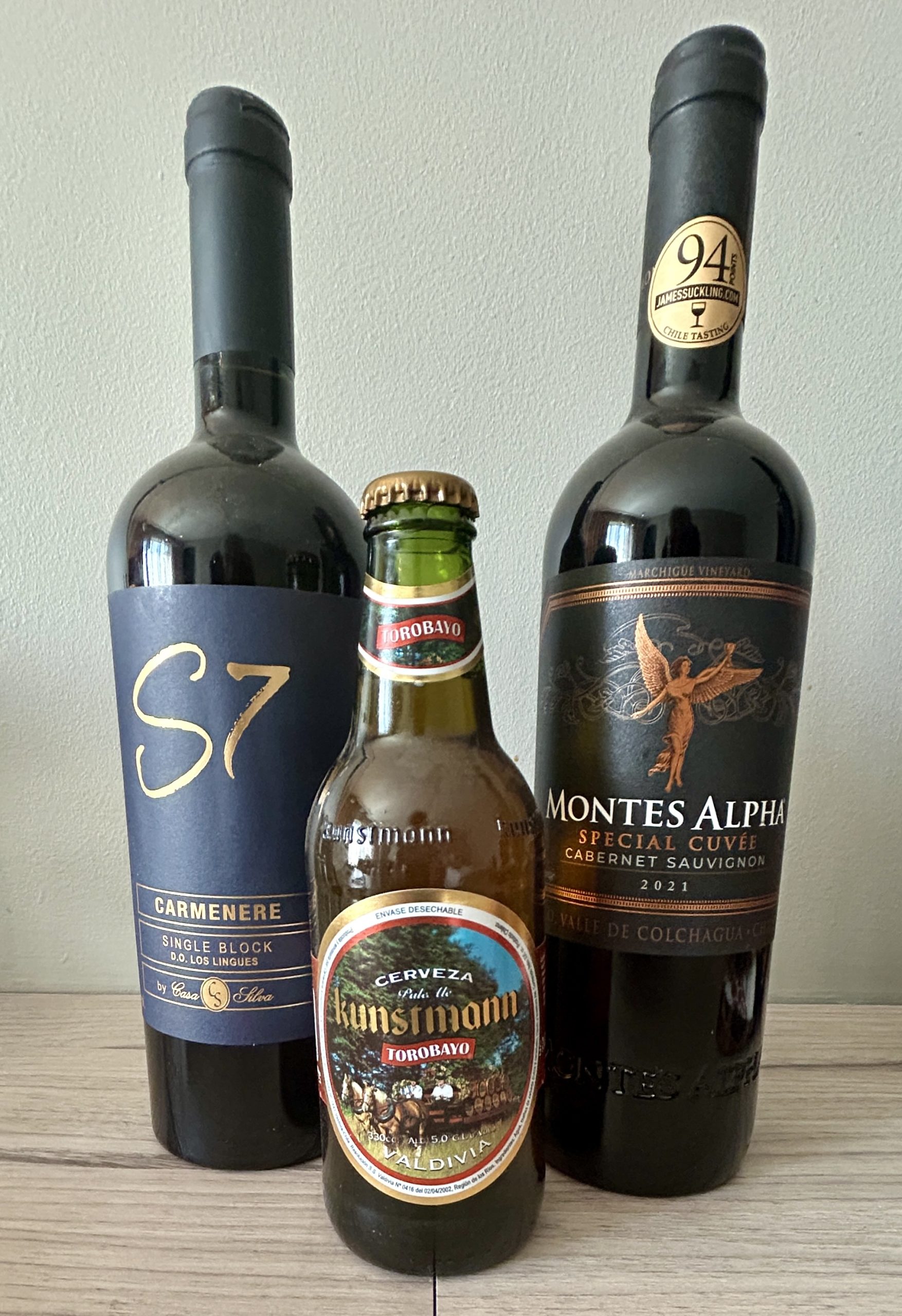
So if you are planning to take this AA trip to Chile I highly recommend arriving early and touring the city with Chris. In fact, if I had to do this again I would arrive three days early and have him take us on a wine tour which is his real specialty. He can be reached at [email protected] or +59 9 9783 0378.
In the next post I’ll give an overview of why touring Chile with Adventures Abroad should be high on your bucket list.

